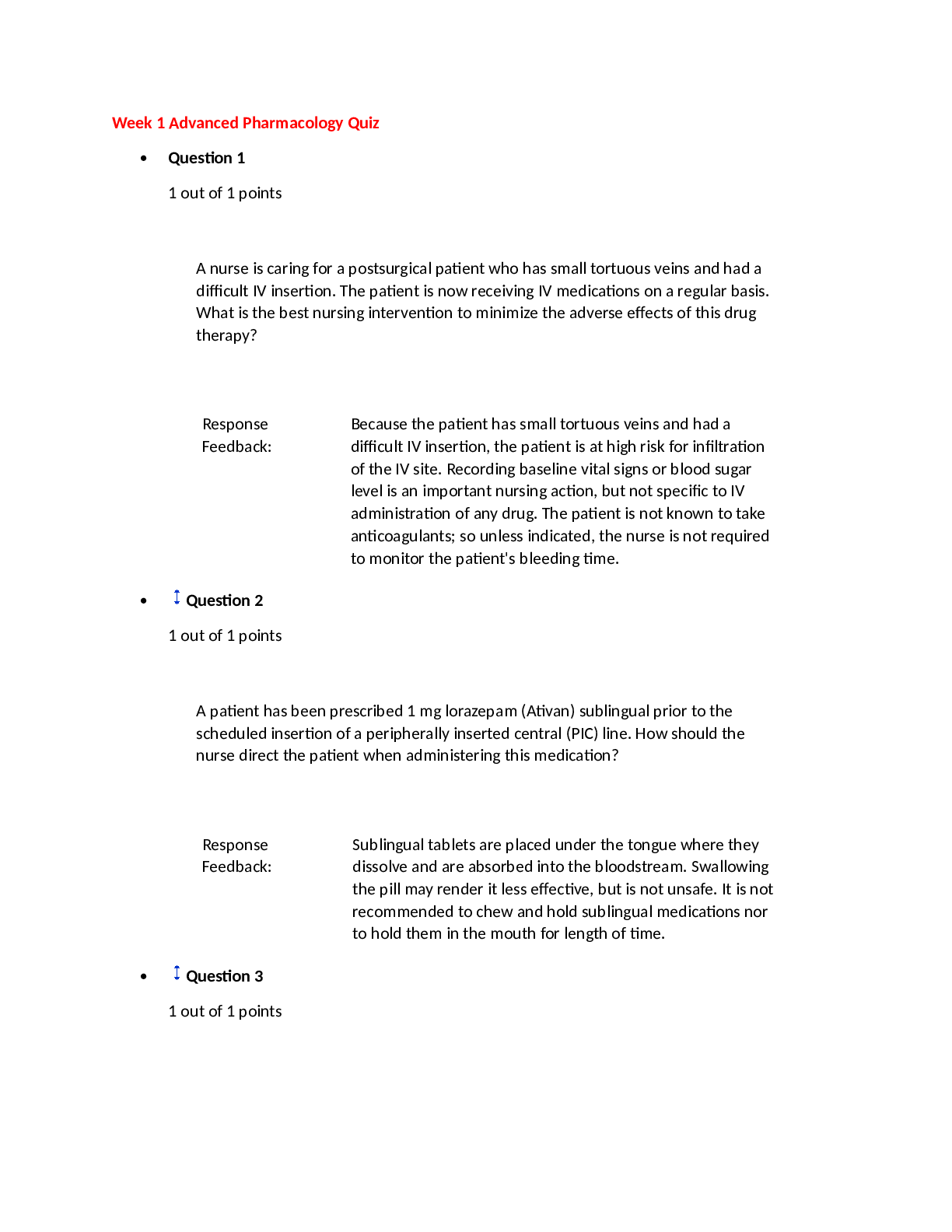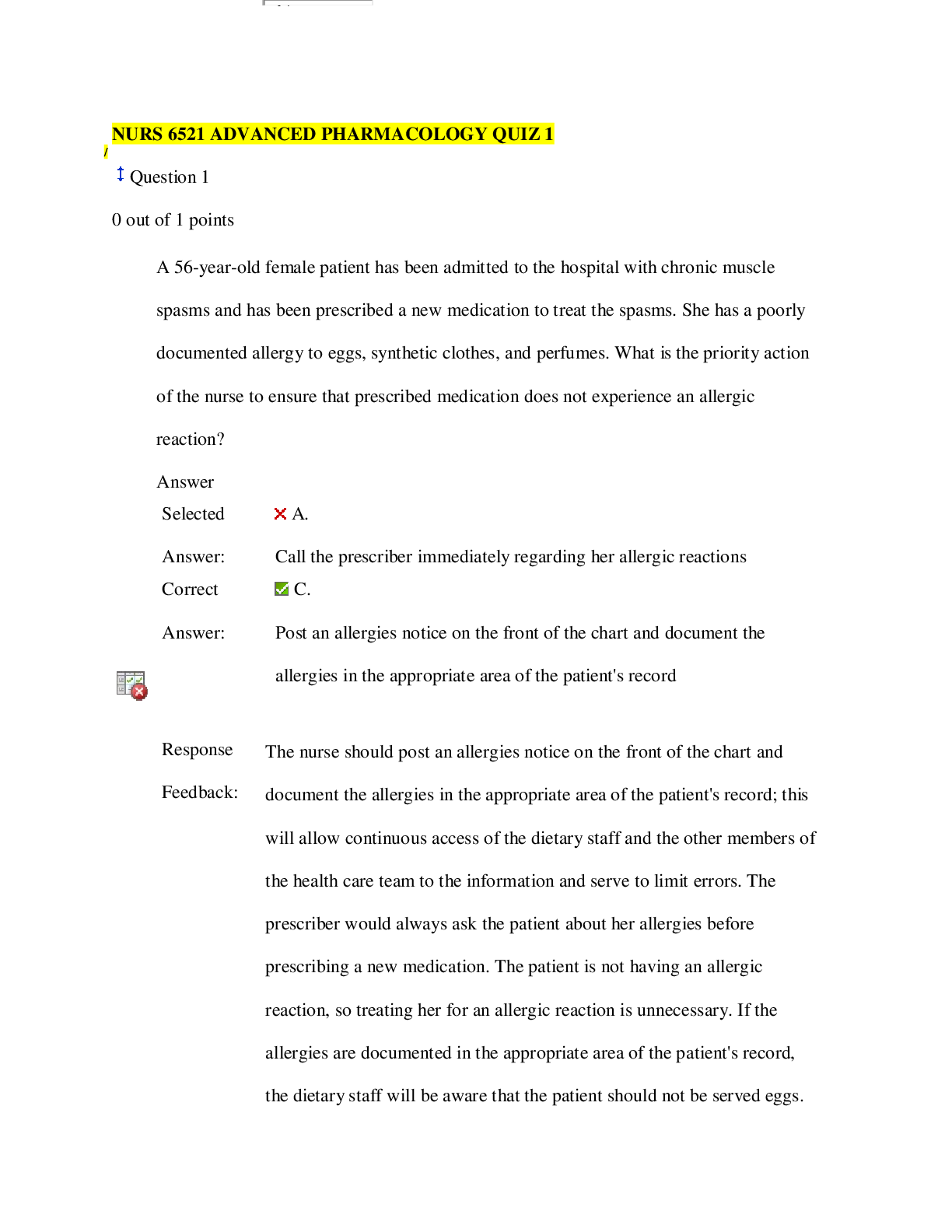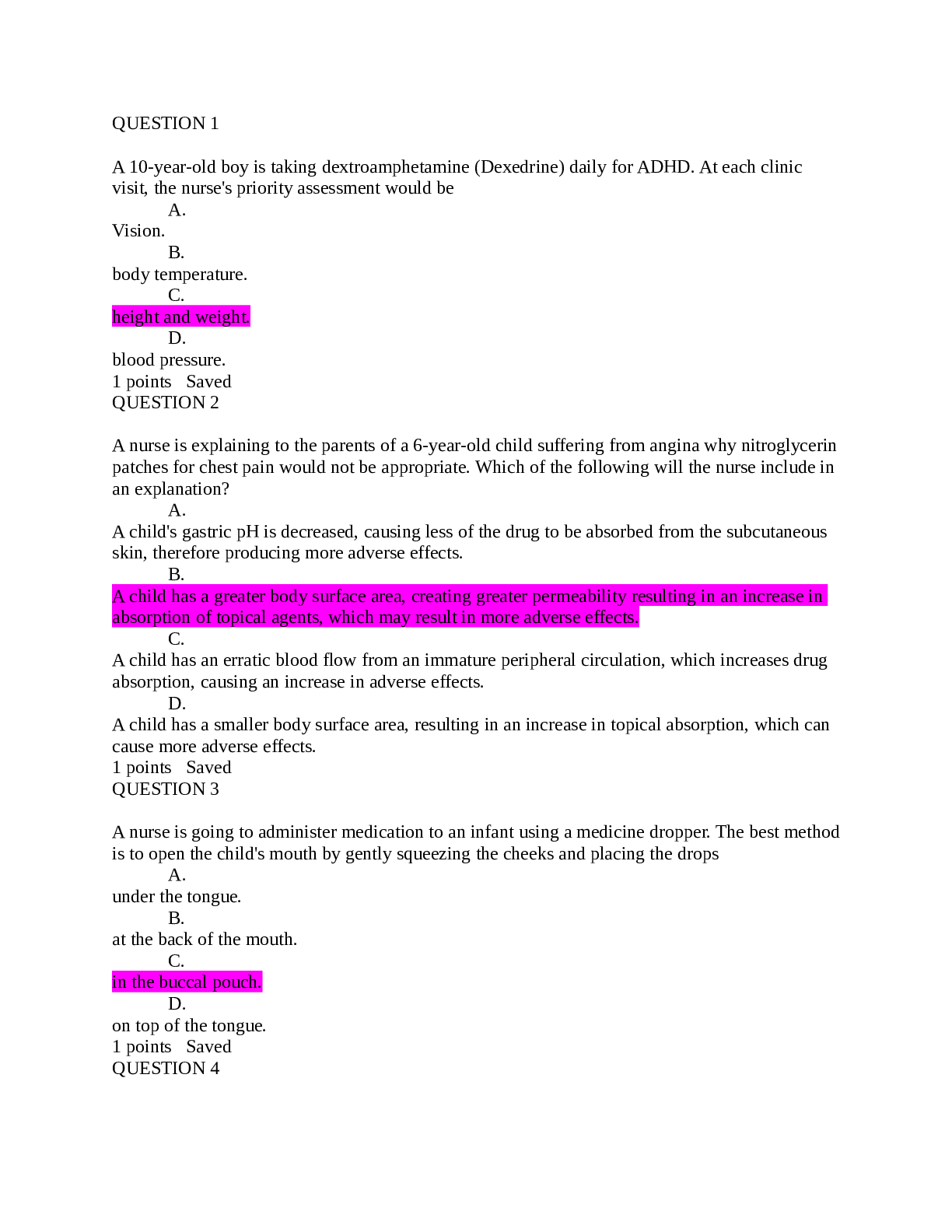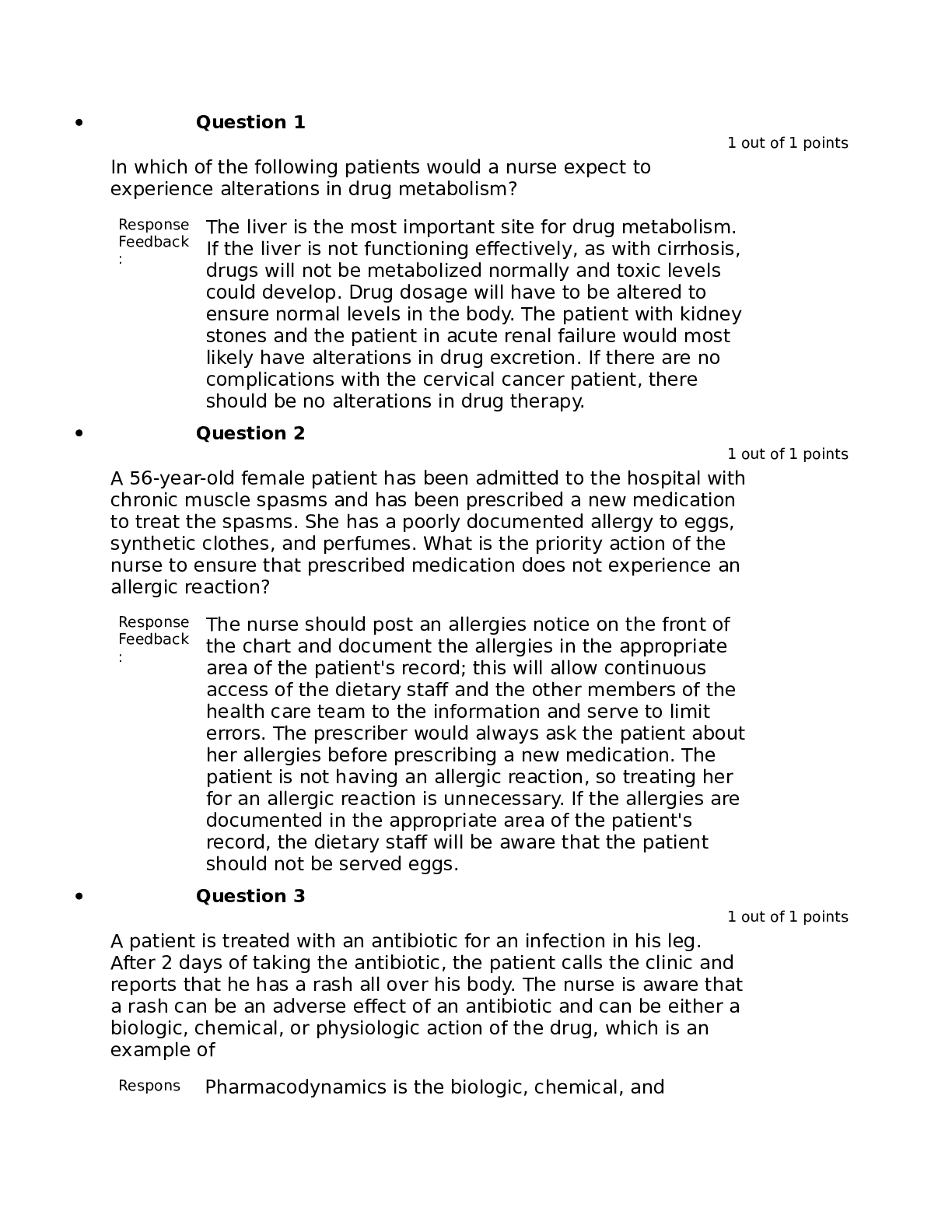Pharmacology > EXAM > NR 508 Advanced Pharmacology Quiz 1_2022/2023 / NR508 Advanced Pharmacology Quiz 1_Graded A+ (All)
NR 508 Advanced Pharmacology Quiz 1_2022/2023 / NR508 Advanced Pharmacology Quiz 1_Graded A+
Document Content and Description Below
NR 508 Advanced Pharmacology Quiz 1 2022 – Chamberlain College of Nursing Nurse practitioner prescriptive authority is regulated by: 1. The National Council of State Boards of Nursing 2. The... U.S. Drug Enforcement Administration 3. The State Board of Nursing for each state 4. The State Board of Pharmacy The benefits to the patient of having an APRN prescriber include: 1. Nurses know more about Pharmacology than other prescribers because they take it both in their basic nursing program and in their APRN program 2. Nurses care for the patient from a holistic approach and include the patient in decision making regarding their care 3. APRNs are less likely to prescribe narcotics and other controlled substances 4. APRNs are able to prescribe independently in all states, whereas a PA needs to have a physician supervising their practice. Clinical judgement in prescribing includes: 1. Factoring in the cost to the patient of the medication prescribed. 2. Always prescribing the newest medication available for the disease process 3. Handing out drug samples to poor patients 4. Prescribing all generic medications to cut cost Criteria for choosing an effective drug for a disorder include: 1. Asking the patient what drug they think would work best for them. 2. Consulting nationally recognized guidelines for disease management 3. Prescribing medications that are available as samples before writing a prescription 4. Following U.S. DEA guidelines for prescribing. Nurse practitioner care may thrive under health-care reform because of: 1. The demonstrated ability of nurse practitioners to control costs and improve patient outcomes. 2. The fact that nurse practitioners will be able to practice independently 3. The fact that nurse practitioners will have full reimbursement under health-care reform 4. The ability to shift accountability for Medicaid to the state level A patient's nutritional intake and laboratory results reflect hypoalbuminemia. This is critical to prescribing because: 1. Distribution of the drugs to the target tissue may be affected 2. The solubility of the drug will not match the site of absorption 3. There will be less free drug available to generate an effect. 4. Drugs bound to albumin are readily excreted by the kidneys Drugs that have a significant first pass effect: 1. Must be given by the enteral (oral) route only 2. Bypass the hepatic circulation 3. Are rapidly metabolized by the liver and may have little if any desired action 4. Are converted by the liver to more active and fat-soluble forms The route of excretion of a volatile drug will likely be the: 1. Kidneys 2. Lungs 3. Bile and feces 4. Skin Depo Provera is prescribed intramuscularly to create a storage reservoir of the drug. Storage reservoirs: 1. Assure that the drug will reach its intended target tissue 2. Are the reason for giving loading doses 3. Increase the length of time a drug is available and active 4. Are most common in collagen tissues The NP chooses to give cephalexin every 8 hours based on knowledge of the drug's: 1. Propensity to go to the target receptor 2. Biological half-life 3. Pharmacodynamics 4. Safety and side effects Azithromycin dosing requires that the first day's dosage be twice those of the other 4 days of the prescription. This is considered a loading dose. A loading dose: 1. Rapidly achieves drug levels in the therapeutic range 2. Requires four or five half lives to attain 3. Is influenced by renal function 4. Is directly related to the drug circulating to the target tissues The point in time on the drug concentration curve that indicates the first sign of a therapeutic effect is the: 1. Minimum adverse effect level 2. Peak of action 3. Onset of action 4. Therapeutic range A laboratory result indicates that the peak level for a drug is above the minimum toxic concentration. This means that the: 1. Concentration will produce therapeutic effects 2. Concentration will produce an adverse response 3. Time between doses must be shortened 4. Duration of action of the drug is too long Drugs that are receptor agonists may demonstrate what property? 1. Irreversible binding to the drug receptor site 2. Up-regulation with chronic use 3. Desensitization or down-regulation with continuous use 4. Inverse relationship between drug concentration and drug action Drugs that are receptor antagonists, such as beta blockers, may cause: 1. Down regulation of the drug receptor 2. And exaggerated response if abruptly discontinued 3. Partial blockade of the effects of agonist drugs 4. An exaggerated response to competitive drug agonists Factors that affect gastric drug absorption include 1. Liver enzyme activity 2. Protein-binding properties of the drug molecule 3. Lipid solubility of the drug 4. Ability to chew and swallow Drugs administered via IV; 1. Need to be lipid soluble in order to be easily absorbed 2. Begin distribution into the body immediately 3. Are easily absorbed if they are non ionized 4. May use pinocytosis to be absorbed When a medication is added to a regimen for a synergistic effect, the combined effect of the drug is: 1. The sum of the effects of each drug individually 2. Greater than the sum of the effects of each drug individually 3. Less that the effect of each drug individually 4. Not predictable, as it varies with each individual use Which of the following statements about bioavailability is true? 1. Bioavailability issues are especially important for drugs with narrow therapeutic ranges or sustained-release mechanisms 2. All brands of drug have the same bioavailability 3. Drugs that are administered more than once a day have a greater bioavailability that drugs given once daily 4. Combining an active drug with an inert substance does not affect bioavailability Which of the following statements about the major distribution barriers (blood-brain or fetal-placental) is true? 1. Water soluble and ionized drugs cross these barriers rapidly. 2. The blood-brain barrier slows the entry of many drugs into and from brain cells. 3. The fetal-placental barrier protects the fetus from drugs taken by the mother. 4. Lipid-soluble drugs do not pass these barriers and are safe for pregnant women. Drugs are metabolized mainly by the liver via phase I or phase II reactions. The purpose of both of these types of reactions is to: 1. Inactivate prodrugs before they can be activated by target tissues 2. Change the drugs so they can cross plasma membranes 3. Change drug molecules to a form that an excretory organ can excrete 4. Make these drugs more ionized and polar to facilitate excretion Once they have been metabolized by the liver, the metabolites may be: 1. More active than the parent drug 2. Less active than the parent drug 3. Totally "deactivated" so they are excreted without any effect 4. All of the above All drugs continue to act in the body until they are changed or excreted. The ability of the body to excrete drugs via the renal system would be increased by: 1. Reduced circulation and perfusion of the kidney 2. Chronic renal disease 3. Competition for a transport site by another drug 4. Unbinding a nonvolatile drug from plasma proteins Steady state is: 1. The point on the drug concentration curve when absorption exceeds excretion 2. When the amount of drug in the body remains constant 3. When the amount of drug in the body stays below the minimum toxic concentration 4. All of the above Two different pain medications are given together for pain relief. The drug—drug interaction is: 1. Synergistic 2. Antagonistic 3. Potentiative 4. Additive Actions taken to reduce drug—drug interaction problems include all of the following EXCEPT: 1. Reducing the dosage of one of the drugs 2. Scheduling their administration at different times 3. Prescribing a third drug to counteract the adverse reaction of the combination 4. Reducing the dosage of both drugs Phase I oxidative-reductive processes of drug metabolism require certain nutritional elements. Which of the following would reduce or inhibit this process? 1. Protein malnutrition 2. Iron-deficiency anemia 3. Both 1 and 2 4. Neither 1 nor 2 The time required for the amount of drug in the body to decrease by 50% is called: 1. Steady state 2. Half-life 3. Phase II metabolism 4. Reduced bioavailability time An agonist activates a receptor and stimulates a response. When given frequently over time, the body may: 1. Upregulate the total number of receptors 2. Block the receptor with a partial agonist 3. Alter the drug's metabolism 4. Downregulate the numbers of that specific receptor Drug antagonism is best defined as an effect of a drug that: 1. Leads to major physiological and psychological dependence 2. Is modified by the concurrent administration of another drug 3. Cannot be metabolized before another dose is administered 4. Leads to a decreased physiological response when combined with another drug Instructions to a client regarding self-administration of oral enteric-coated tablets should include which of the following statements? 1. "Avoid any other oral medicines while taking this drug." 2. "If swallowing this tablet is difficult, dissolve it in 3 ounces of orange juice." 3. "The tablet may be crushed if you have any difficulty taking it." 4. "To achieve best effect, take the tablet with at least 8 ounces of fluid." The major reason for not crushing a sustained-release capsule is that, if crushed, the coated beads of the drugs could possibly result in: 1. Disintegration 2. Toxicity 3. Malabsorption 4. Deterioration Which of the following substances is the most likely to be absorbed in the intestines rather than in the stomach? 1. Sodium bicarbonate 2. Ascorbic acid 3. Salicylic acid 4. Glucose Which of the following variables is a factor in drug absorption? 1. The smaller the surface area for absorption, the more rapidly the drug is absorbed. 2. A rich blood supply to the area of absorption leads to better absorption. 3. The less soluble the drug, the more easily it is absorbed. 4. Ionized drugs are easily absorbed across the cell membrane. An advantage of prescribing a sublingual medication is that the medication is: 1. Absorbed rapidly 2. Excreted rapidly 3. Metabolized minimally 4. Distributed equally Drugs that use CYP 3A4 isoenzymes for metabolism may: 1. Induce the metabolism of another drug 2. Inhibit the metabolism of another drug 3. Both 1 and 2 4. Neither 1 nor 2 Therapeutic drug levels are drawn when a drug reaches steady state. Drugs reach steady state: 1. After the second dose 2. After four to five half-lives 3. When the patient feels the full effect of the drug 4. One hour after IV administration Upregulation or hypersensitization may lead to: 1. Increased response to a drug 2. Decreased response to a drug 3. An exaggerated response if the drug is withdrawn 4. Refractoriness or complete lack of response An NP would prescribe the liquid form of ibuprofen for a 6-year-old child because: 1. Drugs given in liquid form are less irritating to the stomach. 2. A 6-year-old child may have problems swallowing a pill. 3. Liquid forms of medication eliminate the concern for first-pass effect. 4. Liquid ibuprofen does not have to be dosed as often as the tablet form. In deciding which of multiple drugs used to use to treat a condition, the NP chooses Drug A because it: 1. Has serious side effects and it is not being used for a life-threatening condition 2. Will be taken twice daily and will be taken at home 3. Is expensive, but covered by health insurance 4. None of these are important in choosing a drug A client asks the NP about the differences in drug effects between men and women. What is known about the differences between the pharmacokinetics of men and women? 1. Body temperature varies between men and women. 2. Muscle mass is greater in women. 3. Percentage of fat differs between genders. 4. Proven subjective factors exist between the genders. The first step in the prescribing process according to the World Health Organization is: 1. Choosing the treatment 2. Educating the patient about the medication 3. Diagnosing the patient's problem 4. Starting the treatment Treatment goals in prescribing should: 1. Always be curative 2. Be patient-centered 3. Be convenient for the provider 4. Focus on the cost of therapy The therapeutic goals when prescribing include(s): 1. Curative 2. Palliative 3. Preventive 4. All of the above When determining drug treatment the NP prescriber should: 1. Always use evidence-based guidelines 2. Individualize the drug choice for the specific patient 3. Rely on his or her experience when prescribing for complex patients 4. Use the newest drug on the market for the condition being treated Patient education regarding prescribed medication includes: 1. Instructions written at the high school reading level 2. Discussion of expected adverse drug reactions 3. How to store leftover medication such as antibiotics 4. Verbal instructions always in English Passive monitoring of drug effectiveness includes: 1. Therapeutic drug levels 2. Adding or subtracting medications from the treatment regimen 3. Ongoing provider visits 4. Instructing the patient to report if the drug is not effective Pharmacokinetic factors that affect prescribing include: 1. Therapeutic index 2. Minimum effective concentration 3. Bioavailability 4. Ease of titration Pharmaceutical promotion may affect prescribing. To address the impact of pharmaceutical promotion, the following recommendations have been made by the Institute of Medicine: 1. Conflicts of interest and financial relationships should be disclosed by those providing education. 2. Providers should ban all pharmaceutical representatives from their office setting. 3. Drug samples should be used for patients who have the insurance to pay for them, to ensure the patient can afford the medication. 4. Providers should only accept low-value gifts, such as pens and pads of paper, from the pharmaceutical representative. Under new U.S. Food and Drug Administration labeling, Pregnancy Categories will be: 1. Strengthened with a new coding such as C+ or C- to discern when a drug is more or less toxic to the fetus 2. Changed to incorporate a pregnancy risk summary and clinical considerations on the drug label 3. Eliminated, and replaced with a link to the National Library of Medicine TOXNET Web site for in-depth information regarding pregnancy concerns 4. Clarified to include information such as safe dosages in each trimester of pregnancy The U.S. Food and Drug Administration regulates: 1. Prescribing of drugs by MDs and NPs 2. The official labeling for all prescription and over-the-counter drugs 3. Off-label recommendations for prescribing 4. Pharmaceutical educational offerings The U.S. Food and Drug Administration approval is required for: 1. Medical devices, including artificial joints 2. Over-the-counter vitamins 3. Herbal products, such as St John's wort 4. Dietary supplements, such as Ensure An Investigational New Drug is filed with the U.S. Food and Drug Administration: 1. When the manufacturer has completed phase III trials 2. When a new drug is discovered 3. Prior to animal testing of any new drug entity 4. Prior to human testing of any new drug entity Phase IV clinical trials in the United States are also known as: 1. Human bioavailability trials 2. Post marketing research 3. Human safety and efficacy studies 4. The last stage of animal trials before the human trials begin Off-label prescribing is: 1. Regulated by the U.S. Food and Drug Administration 2. Illegal by NPs in all states (provinces) 3. Legal if there is scientific evidence for the use 4. Regulated by the Drug Enforcement Administration The U.S. Drug Enforcement Administration: 1. Registers manufacturers and prescribers of controlled substances 2. Regulates NP prescribing at the state level 3. Sanctions providers who prescribe drugs off-label 4. Provides prescribers with a number they can use for insurance billing Drugs that are designated Schedule II by the U.S. Drug Enforcement Administration: 1. Are known teratogens during pregnancy 2. May not be refilled; a new prescription must be written 3. Have a low abuse potential 4. May be dispensed without a prescription unless regulated by the state Precautions that should be taken when prescribing controlled substances include: 1. Faxing the prescription for a Schedule II drug directly to the pharmacy 2. Using tamper-proof paper for all prescriptions written for controlled drugs 3. Keeping any pre-signed prescription pads in a locked drawer in the clinic 4. Using only numbers to indicate the amount of drug to be prescribed Strategies prescribers can use to prevent misuse of controlled prescription drugs include: 1. Use of chemical dependency screening tools 2. Firm limit-setting regarding prescribing controlled substances 3. Practicing "just say no" to deal with patients who are pushing the provider to prescribe controlled substances 4. All of the above Behaviors predictive of addiction to controlled substances include: 1. Stealing or borrowing another patient's drugs 2. Requiring increasing doses of opiates for pain associated with malignancy 3. Receiving refills of a Schedule II prescription on a regular basis 4. Requesting that only their own primary care provider prescribe for them Medication agreements or "Pain Medication Contracts" are recommended to be used: 1. Universally for all prescribing for chronic pain 2. For patients who have repeated requests for pain medication 3. When you suspect a patient is exhibiting drug-seeking behavior 4. For patients with pain associated with malignancy A prescription needs to be written for: 1. Legend drugs 2. Most controlled drugs 3. Medical devices 4. All of the above Which of the following patients would be at higher risk of experiencing adverse drug reactions (ADRs): 1. A 32-year-old male 2. A 22-year-old female 3. A 3-month-old female 4. A 48-year-old male Infants and young children are at higher risk of ADRs due to: 1. Immature renal function in school-age children 2. Lack of safety and efficacy studies in the pediatric population 3. Children's skin being thicker than adults, requiring higher dosages of topical medication 4. Infant boys having a higher proportion of muscle mass, leading to a higher volume of distribution The elderly are at high risk of ADRs due to: 1. Having greater muscle mass than younger adults, leading to higher volume of distribution 2. The extensive studies that have been conducted on drug safety in this age group 3. The blood-brain barrier being less permeable, requiring higher doses to achieve therapeutic effect 4. Age-related decrease in renal function The type of adverse drug reaction that is idiosyncratic when a drug given in the usual therapeutic doses is type: 1. A 2. B 3. C 4. D Digoxin may cause a type A adverse drug reaction due to: 1. Idiosyncratic effects 2. Its narrow therapeutic index 3. Being a teratogen 4. Being a carcinogen Sarah developed a rash after using a topical medication. This is a type __ allergic drug reaction. 1. I 2. II 3. III 4. IV A patient may develop neutropenia from using topical Silvadene for burns. Neutropenia is a(n): 1. Cytotoxic hypersensitivity reaction 2. Immune complex hypersensitivity 3. Immediate hypersensitivity reaction 4. Delayed hypersensitivity reaction Anaphylactic shock is a: 1. Type I reaction, called immediate hypersensitivity reaction 2. Type II reaction, called cytotoxic hypersensitivity reaction 3. Type III allergic reaction, called immune complex hypersensitivity 4. Type IV allergic reaction, called delayed hypersensitivity reaction James has hypothalamic-pituitary-adrenal axis suppression from chronic prednisone (a corticosteroid) use. He is at risk for what type of adverse drug reaction? 1. Type B 2. Type C 3. Type E 4. Type F Immunomodulators such as azathioprine may cause a delayed adverse drug reaction known as a type D reaction because they are known: 1. Teratogens 2. Carcinogens 3. To cause hypersensitivity reactions 4. Hypothalamus-pituitary-adrenal axis suppressants A 24-year-old male received multiple fractures in a motor vehicle accident that required significant amounts of opioid medication to treat his pain. He is at risk for a _____ adverse drug reaction when he no longer requires the opioids. 1. Rapid 2. First-dose 3. Late 4. Delayed An example of a first-dose reaction that may occur includes: 1. Orthostatic hypotension that does not occur with repeated doses 2. Purple glove syndrome with phenytoin use 3. Hemolytic anemia from ceftriaxone use 4. Contact dermatitis from neomycin use Drugs that are prone to cause adverse drug effects include: 1. Diuretics 2. Inhaled anticholinergics 3. Insulins 4. Stimulants The U.S. Food and Drug Administration MedWatch system is activated when: 1. There is an adverse event to a vaccine. 2. The patient has a severe reaction that is noted in the "Severe Reaction" section in the medication label. 3. A lactating woman takes a medication that is potentially toxic to the breastfeeding infant. 4. An adverse event or serious problem occurs with a medication that is not already identified on the label. The Vaccine Adverse Events Reporting System is: 1. A mandatory reporting system for all health-care providers when they encounter an adverse vaccine event 2. A voluntary reporting system that health-care providers or consumers may use to report vaccine adverse events 3. Utilized to send out safety alerts regarding emerging vaccine safety issues 4. Activated when a vaccine has been proven to cause significant adverse effects A comprehensive assessment of a patient should be holistic when trying to determine competence in drug administration. Which of the following factors would the NP omit from this type of assessment? 1. Financial status 2. Mobility 3. Social support 4. Sexual practices Elena Vasquez's primary language is Spanish, and she speaks very limited English. Which technique would be appropriate to use in teaching her about a new drug you have just prescribed? 1. Use correct medical terminology because Spanish has a Latin base. 2. Use a family member who speaks more English to act as an interpreter. 3. Use a professional interpreter or a reliable staff member who can act as an interpreter. 4. Use careful, detailed explanations. Rod, age 68, has hearing difficulty. Which of the following would NOT be helpful in assuring that he understands teaching about his drug? 1. Stand facing him and speak slowly and clearly. 2. Speak in low tones or find a provider who has a lower voice. 3. Write down the instructions as well as speaking them. 4. If he reads lips, exaggerate lips movements when pronouncing the vowel sounds. Which of the following factors may adversely affect a patient's adherence to a therapeutic drug regimen? 1. Complexity of the drug regimen 2. Patient perception of the potential adverse effects of the drugs 3. Both 1 and 2 4. Neither 1 nor 2 The health-care delivery system itself can create barriers to adherence to a treatment regimen. Which of the following system variables creates such a barrier? 1. Increasing copayments for care 2. Unrestricted formularies for drugs, including brand names 3. Increasing the number of people who have access to care 4. Treating a wider range of disorders Ralph's blood pressure remains elevated despite increased doses of his drug. The NP is concerned that he might not be adhering to his treatment regimen. Which of the following events would suggest that he might not be adherent? 1. Ralph states that he always takes the drug "when I feel my pressure is going up." 2. Ralph contacts his NP to discuss the need to increase the dosage. 3. Ralph consistently keeps his follow-up appointments to check his blood pressure. 4. All of the above show that he is adherent to the drug regimen. Nonadherence is especially common in drugs that treat asymptomatic conditions, such as hypertension. One way to reduce the likelihood of nonadherence to these drugs is to prescribe a drug that: 1. Has a short half-life so that missing one dose has limited effect 2. Requires several dosage titrations so that missed doses can be replaced with lower doses to keep costs down 3. Has a tolerability profile with fewer of the adverse effects that are considered "irritating," such as nausea and dizziness 4. Must be taken no more than twice a day Factors in chronic conditions that contribute to nonadherence include: 1. The complexity of the treatment regimen 2. The length of time over which it must be taken 3. Breaks in the usual daily routine, such as vacations and weekends 4. All of the above While patient education about their drugs is important, information alone does not necessarily lead to adherence to a drug regimen. Patients report greater adherence when: 1. The provider spent a lot of time discussing the drugs with them 2. Their concerns and specific area of knowledge deficit were addressed 3. They were given written material, such as pamphlets, about the drugs 4. The provider used appropriate medical and pharmacological terms Patients with psychiatric illnesses have adherence rates to their drug regimen between 35% and 60%. To improve adherence in this population, prescribe drugs: 1. With a longer half-life so that missed doses produce a longer taper on the drug curve 2. In oral formulations that are more easily taken 3. That do not require frequent monitoring 4. Combined with patient education about the need to adhere even when symptoms are absent Many disorders require multiple drugs to treat them. The more complex the drug regimen, the less likely the patient will adhere to it. Which of the following interventions will NOT improve adherence? 1. Have the patient purchase a pill container with compartments for daily or multiple times-per-day dosing. 2. Match the clinic appointment to the next time the drug is to be refilled. 3. Write prescriptions for new drugs with shorter times between refills. 4. Give the patient a clear drug schedule that the provider devises to fit the characteristic of the drug. Pharmacologic interventions are costly. Patients for whom the cost/benefit variable is especially important include: 1. Older adults and those on fixed incomes 2. Patients with chronic illnesses 3. Patients with copayments for drugs on their insurance 4. Patients on public assistance Providers have a responsibility for determining the best plan of care, but patients also have responsibilities. Patients the provider can be assured will carry through on these responsibilities include those who: 1. Are well-educated and affluent 2. Have chronic conditions 3. Self-monitor drug effects on their symptoms 4. None of the above guarantee adherence Monitoring adherence can take several forms, including: 1. Patient reports from data in a drug diary 2. Pill counts 3. Laboratory reports and other diagnostic markers 4. All of the above Factors that explain and predict medication adherence include: 1. Social 2. Financial 3. Health system 4. All of the above Cultural factors that must be taken into account when prescribing include(s): 1. Who the decision maker is in the family regarding health-care decisions 2. The patient's view of health and illness 3. Attitudes regarding the use of drugs to treat illness 4. All of the above Ethnic differences have been found in drug: 1. Absorption 2. Hepatic metabolism 3. Filtration at the glomerulus 4. Passive tubular reabsorption The National Standards of Culturally and Linguistically Appropriate Services are required to be implemented in all: 1. Hospitals 2. Clinics that serve the poor 3. Organizations that receive federal funds 4. Clinics that serve ethnic minorities According to the National Standards of Culturally and Linguistically Appropriate Services, an interpreter for health care: 1. May be a bilingual family member 2. May be a bilingual nurse or other health-care provider 3. Must be a professionally trained medical interpreter 4. Must be an employee of the organization According to the U.S. Office of Minority Health, poor health outcomes among African Americans are attributed to: 1. The belief among African Americans that prayer is more powerful than drugs 2. Poor compliance on the part of the African American patient 3. The genetic predisposition for illness found among African Americans 4. Discrimination, cultural barriers, and lack of access to health care The racial difference in drug pharmacokinetics seen in American Indian or Alaskan Natives are: 1. Increased CYP 2D6 activity, leading to rapid metabolism of some drugs 2. Largely unknown due to lack of studies of this population 3. Rapid metabolism of alcohol, leading to increased tolerance 4. Decreased elimination of opioids, leading to increased risk for addiction Pharmacokinetics among Asians are universal to all the Asian ethnic groups. 1. True 2. False Alterations in drug metabolism among Asians may lead to: 1. Slower metabolism of antidepressants, requiring lower doses 2. Faster metabolism of neuroleptics, requiring higher doses 3. Altered metabolism of omeprazole, requiring higher doses 4. Slower metabolism of alcohol, requiring higher doses Asians from Eastern Asia are known to be fast acetylators. Fast acetylators: 1. Require acetylization in order to metabolize drugs 2. Are unable to tolerate higher doses of some drugs that require acetylization 3. May have a toxic reaction to drugs that require acetylization 4. Require higher doses of drugs metabolized by acetylization to achieve efficacy Hispanic native healers (curanderas): 1. Are not heavily utilized by Hispanics who immigrate to the United States 2. Use herbs and teas in their treatment of illness 3. Provide unsafe advice to Hispanics and should not be trusted 4. Need to be licensed in their home country in order to practice in the United States The most frequent type of drug-food interaction is food: 1. Causing increased therapeutic drug levels 2. Affecting the metabolism of the drug 3. Altering the volume of distribution of drugs 4. Affecting the gastrointestinal absorption of drugs Food in the gastrointestinal tract affects drug absorption by: 1. Altering the pH of the colon, which decreases absorption 2. Competing with the drug for plasma proteins 3. Altering gastric emptying time 4. Altering the pH of urine Food can alter the pH of the stomach, leading to: 1. Enhanced drug metabolism 2. Altered vitamin K absorption 3. Increased vitamin D absorption 4. Altered drug bioavailability Fasting for an extended period can: 1. Increase drug absorption due to lack of competition between food and the drug 2. Alter the pH of the gastrointestinal tract, affecting absorption 3. Cause vasoconstriction, leading to decreased drug absorption 4. Shrink the stomach, causing decreased surface area for drug absorption Tetracycline needs to be given on an empty stomach because it chelates with: 1. Calcium 2. Magnesium 3. Iron 4. All of the above A low-carbohydrate, high-protein diet may: 1. Increase drug-metabolizing enzymes 2. Decrease drug absorption from the GI tract 3. Alter drug binding to plasma proteins 4. Enhance drug elimination Grapefruit juice contains furanocoumarins that have been found to: 1. Alter absorption of drugs through competition for binding sites 2. Inhibit CYP 3A4, leading to decreased first-pass metabolism of drugs 3. Alter vitamin K metabolism, leading to prolonged bleeding 4. Enhance absorption of calcium and vitamin D Cruciferous vegetables may alter drug pharmacokinetics by: 1. Enhancing absorption of weakly acidic drugs 2. Altering CYP 3A4 activity, leading to elevated levels of drugs, such as the statins 3. Inducing CYP 1A2, possibly leading to therapeutic failure of drugs metabolized by CYP 1A2 4. Decreasing first-pass metabolism of drugs Milk and other foods that alkalinize the urine may: 1. Result in basic drugs being reabsorbed in the renal tubule 2. Increase the elimination of basic drugs in the urine 3. Decrease the elimination of acidic drugs 4. Not alter drug elimination due to the minimal change in urine pH Antacids such as calcium carbonate (Tums) can reduce the absorption of which of the following nutrients? 1. Protein 2. Calcium 3. Iron 4. Vitamin K Phenytoin decreases folic acid absorption by: 1. Altering the pH of the stomach 2. Increasing gastric emptying time 3. Inhibiting intestinal enzymes required for folic acid absorption 4. Chelation of the folic acid into inactive ingredients Patients taking warfarin need to be educated about the vitamin K content of foods to avoid therapeutic failure. Foods high in vitamin K that should be limited to no more than one serving per day include: 1. Spinach 2. Milk 3. Romaine lettuce 4. Cauliflower The American Dietetic Association has recommended the use of specific nutritional supplements in the following population(s): 1. 400 IU per day of vitamin D in all infants and children 2. 1,000 IU per day of vitamin D for all pregnant women 3. 60 mg per day of iron for all adults over age 50 years 4. All of the above The American Dietetic Association recommends pregnant women take a supplement including: 1. 1,000 IU daily of vitamin D 2. 2.4 mcg/day of vitamin B12 3. 600 mcg/day of folic acid 4. 8 mg/day of iron The American Heart Association and the American Dietetic Association recommend a minimum daily fiber intake of ______ for cardiovascular health: 1. 10 mg/day 2. 15 mg/day 3. 20 mg/day 4. 25 mg/day Which of the following vitamin or mineral supplements may by teratogenic if a pregnant woman takes more than the recommended amount? 1. Iron 2. Vitamin A 3. Vitamin B6 4. Vitamin C Vitamin B2 (riboflavin) may be prescribed to: 1. Decrease the incidence of beriberi 2. Reduce headaches and migraines 3. Prevent pernicious anemia 4. Treat hyperlipidemia Isoniazid (INH) may induce a deficiency of which vitamin? 1. B6 2. C 3. D 4. E Pregnant patients who are taking isoniazid (INH) should take 25 mg/day of vitamin B6 (pyridoxine) to prevent: 1. Beriberi 2. Peripheral neuropathy 3. Rickets 4. Megaloblastic anemia Vitamin B12 deficiency may lead to: 1. Hair loss 2. Insomnia 3. Dry scales on the scalp 4. Numbness and tingling of the hands Smokers are at risk for vitamin C deficiency. It is recommended that smokers take _______ vitamin C supplement. 1. 100 mg/day 2. 500 mg/day 3. 1,000 mg/day 4. 35 mg/day more than nonsmokers There is strong evidence to support that adequate vitamin C intake prevents: 1. The common cold 2. Breast cancer 3. Scurvy 4. All of the above Adequate vitamin D is needed for: 1. Absorption of calcium from the gastrointestinal tract 2. Regulation of serum calcium levels 3. Regulation of serum phosphate levels 4. All of the above Newborns are at risk for early vitamin K deficiency bleeding and the American Academy of Pediatrics recommends that all newborns receive: 1. IM vitamin K (phytonadione) within 24 hours of birth 2. Oral vitamin K supplementation in the first 3 weeks of life 3. Formula containing vitamin K or breast milk 4. Oral vitamin K in the first 24 hours after birth Symptoms of folate deficiency include: 1. Thinning of the hair 2. Bruising easily 3. Glossitis 4. Numbness and tingling of the hands and feet A patient with a new onset of systolic ejection murmur should be assessed for which nutritional deficiency? 1. Vitamin B12 2. Vitamin C 3. Folate 4. Niacine According to the 2003-2006 National Health and Nutrition Examination Survey study of dietary intake, the group at highest risk for inadequate calcium intake was: 1. The elderly (over age 60 years) 2. Teenage females 3. Teenage males 4. Preschoolers Patients with iron deficiency will develop: 1. Hemolytic anemia 2. Megaloblastic anemia 3. Macrocytic-hypochromic anemia 4. Microcytic-hypochromic anemia There is evidence that dietary supplementation or adequate intake of fish oils and omega-3 fatty acids have well-documented: 1. Concern for developing cardiac dysrhythmias 2. Anti-inflammatory effects 3. Total cholesterol-lowering effects 4. Effects on fasting blood sugar There is enough preliminary evidence to recommend that children with autism receive which supplemental nutrient? 1. Vitamin B1 (thiamine) 2. Vitamin B2 (riboflavin) 3. Calcium 4. Omega-3 fatty acids There is sufficient evidence to support the use of omega-3 fatty acids to treat the following disease(s): 1. Asthma 2. Autism 3. Arthritis 4. All of the above It is reasonable to recommend supplementation with _________ in the treatment of hyperlipidemia. 1. Omega-3 fatty acids 2. Probiotics 3. Plant sterols 4. Calcium Probiotics are recommended to be co-administered when ____________ are prescribed: 1. Antacids 2. Antihypertensives 3. Antidiarrheals 4. Antibiotics It is reasonable to add ___________ to a Helicobacter pylori treatment regimen to improve eradication rates of H. pylori. 1. Probiotics 2. Omega-3 fatty acids 3. Plant sterols 4. Fiber Pharmacoeconomics is: 1. The study of the part of the U.S. economy devoted to drug use 2. The study of the impact of prescription drug costs on the overall economy 3. The analysis of the costs and consequences of any health-care-related treatment or service 4. The analysis of the clinical efficacy of the drug The direct costs of drug therapy include: 1. The actual cost of acquiring the medication 2. The loss of income due to illness 3. Pain and suffering due to inadequate drug therapy 4. The cost of a funeral associated with premature death Indirect costs associated with drug therapy include: 1. The cost of diagnostic tests to monitor therapeutic levels 2. Health-care provider time to prescribe and educate the patient 3. Child-care expenses incurred while receiving therapy 4. Loss of wages while undergoing drug therapy The intangible costs of drug therapy include: 1. Loss of wages while undergoing therapy 2. Inconvenience, pain, and suffering incurred with therapy 3. Cost of medical equipment in the laboratory used to monitor therapeutic drug levels 4. Cost of prescription drug coverage, such as Medicare Part D When a pharmacoeconomic analysis looks at two or more treatment alternatives that are considered equal in efficacy and compares the costs of each it is referred to as: 1. Cost-minimization analysis 2. Cost-of-illness analysis 3. Cost-effectiveness analysis 4. Cost-benefit analysis Cost-effectiveness analysis compares two or more treatments or programs that are: 1. Not necessarily therapeutically equivalent 2. Considered equal in efficacy 3. Compared with the dollar value of the benefit received 4. Expressed in terms of patient preference or quality-adjusted life years When the costs of a specific treatment or intervention are calculated and then compared with the dollar value of the benefit received it is referred to as: 1. Cost-minimization analysis 2. Cost-of-illness analysis 3. Cost-effectiveness analysis 4. Cost-benefit analysis Mary has a two-tiered prescription benefit plan, which means: 1. She can receive differing levels of care based on whether she chooses an "in-plan" provider or not. 2. She is eligible for the new Medicare Part D "donut hole" reduction of costs program. 3. She pays a higher copay for brand-name drugs than for generic drugs. 4. She must always choose to be treated with generic drugs first. Prescribing less-expensive generic drugs or drugs off the $4 retail pharmacy lists: 1. Increases the complexity of the pharmacoeconomics of prescribing for the individual patient 2. Increases compliance by reducing the financial burden of drug costs to the patient 3. Is not sound prescribing practice due to the inferiority of the generic products 4. Will increase the overall cost of drugs to the system due to the ease of overprescribing less-expensive drugs James tells you that he is confused by his Medicare Part D coverage plan. An appropriate intervention would be: 1. Order cognitive testing to determine the source of his confusion. 2. Sit down with him and explain the whole Medicare Part D process. 3. Refer him to the Medicare specialist in his insurance plan to explain the benefit to him. 4. Request his son come to the next appointment so you can explain the benefit to him. The "donut hole" in Medicare Part D: 1. Will be totally eliminated with the federal health-care reform enacted in 2010 2. Refers to the period of time when annual individual drug costs are between $250 and $2,250 per year and drug costs are covered 75% 3. Refers to the period between when the annual individual drug costs are $2,970 and $4,750 and the patient pays 52.5% of the costs of brand name drugs (2013) 4. Has no effect on whether patients continue to fill their prescriptions during the coverage gap Research has shown that when patients who are covered by Medicare Part D reach the "donut hole" in coverage they: 1. Ask for extra refills of medication to get them through the months of no coverage 2. Fill their prescriptions less frequently, including critical medications such as warfarin or a statin 3. Fill their critical medications, but hold off on filling less-critical medications 4. Demonstrate no change in their prescription filling pattern Michael asks you about why some drugs are over-the-counter and some are prescription. You explain that in order for a drug to be approved for over-the-counter use the drug must: 1. Be safe and labeled for appropriate use 2. Have a low potential for abuse or misuse 3. Be taken for a condition the patient can reliably self-diagnose 4. All of the above In the United States, over-the-counter drugs are regulated by: 1. No one. There is no oversight for over-the-counter medications. 2. The U.S. Food and Drug Administration Center for Drug Evaluation and Research 3. The U.S. Drug Enforcement Administration 4. MedWatch As drugs near the end of their patent, pharmaceutical companies may apply for the drug to change to over-the-counter status in order to: 1. Get a new patent for the over-the-counter form of the drug 2. Lower the costs because most prescription benefit plans do not cover generics 3. Market the drug to a whole new population, as they are able to market to patients instead of just providers 4. Continue to make large profits from their blockbuster brand-name drug New over-the-counter drug ingredients must undergo the U.S. Food and Drug Administration New Drug Application process, just as prescription drugs do. 1. True 2. False The ailment that generates the greatest over-the-counter annual drug sales is: 1. Constipation 2. Cough and colds 3. Heartburn 4. Acute and chronic pain Common over-the-counter pain relievers such as acetaminophen or ibuprofen: 1. Are always safer for the patient than prescription pain medication 2. Are harmful if taken in higher than recommended amounts 3. Have minimal interaction with prescription medications 4. Should never be given to children unless recommended by their provider When obtaining a drug history from Harold, he gives you a complete list of his prescription medications. He denies taking any other drugs, but you find that he occasionally takes aspirin for his arthritis flare ups. This is an example of: 1. His appropriately only telling you about his regularly prescribed medications 2. His hiding information regarding his inappropriate use of aspirin from you 3. A common misconception that intermittently taken over-the counter medications are not an important part of his drug history 4. A common misuse of over-the-counter aspirin The Combat Methamphetamine Epidemic Act, which is part of the 2006 U.S. Patriot Act: 1. Requires all providers to screen their patients for methamphetamine use 2. Restricts the prescribing of amphetamines to U.S. citizens 3. Requires a prescription be written for all methamphetamine precursors in all states 4. Restricts the sales of drugs that contain methamphetamine precursors, including a daily and 30-day limit on sales When prescribing a tetracycline or quinolone antibiotic it is critical to instruct the patient: 1. Not to take their regularly prescribed medications while on these antibiotics 2. Regarding the need for lots of acidic foods and juices, such as orange juice, to enhance absorption 3. Not to take antacids while on these medications, as the antacid decreases absorption 4. That there are no drug interactions with these antibiotics Factors that place a patient at risk of developing an antimicrobial-resistant organism include: 1. Age over 50 years 2. School attendance 3. Travel within the U.S. 4. Inappropriate use of antimicrobials Infants and young children are at higher risk of developing antibiotic-resistant infections due to: 1. Developmental differences in pharmacokinetics of the antibiotics in children 2. The fact that children this age are more likely to be in daycare and exposed to pathogens from other children 3. Parents of young children insisting on preventive antibiotics so they don't miss work when their child is sick 4. Immunosuppression from the multiple vaccines they receive in the first 2 years of life Providers should use an antibiogram when prescribing. An antibiogram is: 1. The other name for the Centers for Disease Control guidelines for prescribing antibiotics 2. An algorithm used for prescribing antibiotics for certain infections 3. The reference also known as the Pink Book, published by the Centers for Disease Control 4. A chart of the local resistance patterns to antibiotics developed by laboratories There is often cross-sensitivity and cross-resistance between penicillins and cephalosporins because: 1. Renal excretion is similar in both classes of drugs. 2. When these drug classes are metabolized in the liver they both produce resistant enzymes. 3. Both drug classes contain a beta-lactam ring that is vulnerable to beta-lactamase-producing organisms. 4. There is not an issue with cross-resistance between the penicillins and cephalosporins. Jonathan has been diagnosed with strep throat and needs a prescription for an antibiotic. He says the last time he had penicillin he developed a red, blotchy rash. An appropriate antibiotic to prescribe would be: 1. Penicillin VK, because his rash does not sound like a serious rash 2. Amoxicillin 3. Cefadroxil (Duricef) 4. Azithromycin Sarah is a 25-year-old female who is 8 weeks pregnant and has a urinary tract infection. What would be the appropriate antibiotic to prescribe for her? 1. Ciprofloxacin (Cipro) 2. Amoxicillin (Trimox) 3. Doxycycline 4. Trimethoprim-sulfamethoxazole (Septra) Pong-tai is a 12-month-old child who is being treated with amoxicillin for acute otitis media. His parents call the clinic and say he has developed diarrhea. The appropriate action would be to: 1. Advise the parents that some diarrhea is normal with amoxicillin and recommend probiotics daily. 2. Change the antibiotic to one that is less of a gastrointestinal irritant. 3. Order stool cultures for suspected viral pathogens not treated by the amoxicillin. 4. Recommend increased fluids and fiber in his diet. Lauren is a 13-year-old child who comes to clinic with a 4-day history of cough, low-grade fever, and rhinorrhea. When she blows her nose or coughs the mucous is greenish-yellow. The appropriate antibiotic to prescribe would be: 1. Amoxicillin 2. Amoxicillin/clavulanate 3. TMP/SMZ (Septra) 4. None Joanna had a small ventricle septal defect (VSD) repaired when she was 3 years old and has no residual cardiac problems. She is now 28 and is requesting prophylactic antibiotics for an upcoming dental visit. The appropriate antibiotic to prescribe according to current American College of Cardiology and American Heart Association guidelines is: 1. None, no antibiotic is required for dental procedures 2. Amoxicillin 2 grams 1 hour before the procedure 3. Ampicillin 2 grams IM or IV 30 minutes before the procedure 4. Azithromycin 1 gram 1 hour before the procedure To prevent further development of antibacterial resistance it is recommended that fluoroquinolones be reserved for treatment of: 1. Urinary tract infections in young women 2. Upper respiratory infections in adults 3. Skin and soft tissue infections in adults 4. Community-acquired pneumonia in patients with comorbidities Fluoroquinolones have a Black Box Warning regarding ________ even months after treatment. 1. Renal dysfunction 2. Hepatic toxicity 3. Tendon rupture 4. Development of glaucoma Janet was recently treated with clindamycin for an infection. She calls the advice nurse because she is having frequent diarrhea that she thinks may have blood in it. What would be the appropriate care for her? 1. Encourage increased fluids and fiber. 2. Assess her for pseudomembranous colitis. 3. Advise her to eat yogurt daily to help restore her gut bacteria. 4. Start her on an antidiarrheal medication. Keng has chronic hepatitis that has led to mildly impaired liver function. He has an infection that would be best treated by a macrolide. Which would be the best choice for a patient with liver dysfunction? 1. Azithromycin (Zithromax) 2. Clarithromycin (Biaxin) 3. Erythromycin (E-mycin) 4. None of the above Jamie has glucose-6-phosphate dehydrogenase deficiency (G6PD) and requires an antibiotic. Which class of antibiotics should be avoided in this patient? 1. Penicillin’s 2. Macrolides 3. Cephalosporins 4. Sulfonamides If a patient is allergic to sulfonamide antibiotics, he or she will most likely have cross-sensitivity to: 1. Loop diuretics 2. Sulfonylureas 3. Thiazide diuretics 4. All of the above Tetracyclines such as minocycline are safe to use in: 1. Pregnant women 2. Adolescents 3. Patients with renal dysfunction 4. Patients with hepatic dysfunction Tetracyclines should not be prescribed to children younger than 8 years due to: 1. Risk of developing cartilage problems 2. Development of significant diarrhea 3. Risk of kernicterus 4. Adverse effects on bone growth Nicole is a 16-year-old female who is taking minocycline for acne. She comes to the clinic complaining of a headache. What would be the plan of care? 1. Advise acetaminophen or ibuprofen as needed for headaches. 2. Prescribe sumatriptan (Imitrex) to be taken at the onset of the headache. 3. Evaluate her for pseudotremor cerebri. 4. Assess her caffeine intake and sleep patterns. Patricia has been prescribed doxycycline for a chlamydia infection. She is healthy and her only medication is an oral combined contraceptive. Patricia's education would include: 1. Use a back-up method of birth control (condom) until her next menses. 2. Doxycycline may cause tendonitis and she should report any joint pain. 3. Her partner will need treatment if her infection doesn't clear with the doxycycline. 4. Doxycycline is used for one-dose treatment of STIs; take the whole prescription at once. To prevent the development of peripheral neuropathy in patients taking isoniazid for tuberculosis the patient is also prescribed: 1. Niacin (vitamin B3) 2. Pyridoxine (vitamin B6) 3. Riboflavin (vitamin B2) 4. Thiamine (vitamin B1) Sadie is an 82-year-old patient who has herpes zoster (shingles) and would benefit from an antiviral such as valacyclovir. Prior to prescribing valacyclovir she will need an assessment of: 1. Complete blood count to rule out anemia 2. Liver function 3. Renal function 4. Immunocompetence When prescribing acyclovir, patients should be educated regarding the: 1. High risk of developing diarrhea 2. Need to drink lots of fluids during treatment 3. Risk for life-threatening rash such as Stevens-Johnson 4. Eccentric dosing schedule Nicholas has been diagnosed with type A influenza. Appropriate prescribing of oseltamivir (Tamiflu) would include: 1. Starting oseltamivir within the first 48 hours of influenza symptoms 2. Advising the patient he can stop the oseltamivir when his symptoms resolve 3. Educating the patient that oseltamivir will cure influenza 4. Prophylactic treatment of all family members Monitoring for patients who are on long-term antifungal therapy with ketoconazole includes: 1. Platelet count 2. BUN and creatinine 3. White blood cell count 4. AST, ALT, alkaline phosphatase, and bilirubin When prescribing metronidazole (Flagyl) to treat bacterial vaginosis, patient education would include: 1. Metronidazole is safe in the first trimester of pregnancy. 2. Consuming alcohol in any form may cause a severe reaction. 3. Sexual partners need concurrent therapy. 4. Headaches are a sign of a serious adverse reaction and need immediate evaluation. Every antibiotic drug class has resistant organisms that influence prescribing decisions. 1. True 2. False [Show More]
Last updated: 1 year ago
Preview 1 out of 11 pages

Reviews( 2 )

by CorneaRobert · 2 years ago
Thankyou for the feedback, all the best in your studies by Martin Freeman. 2 years ago

by Martin Freeman · 2 years ago
Document information
Connected school, study & course
About the document
Uploaded On
Jun 03, 2020
Number of pages
11
Written in
Additional information
This document has been written for:
Uploaded
Jun 03, 2020
Downloads
1
Views
97


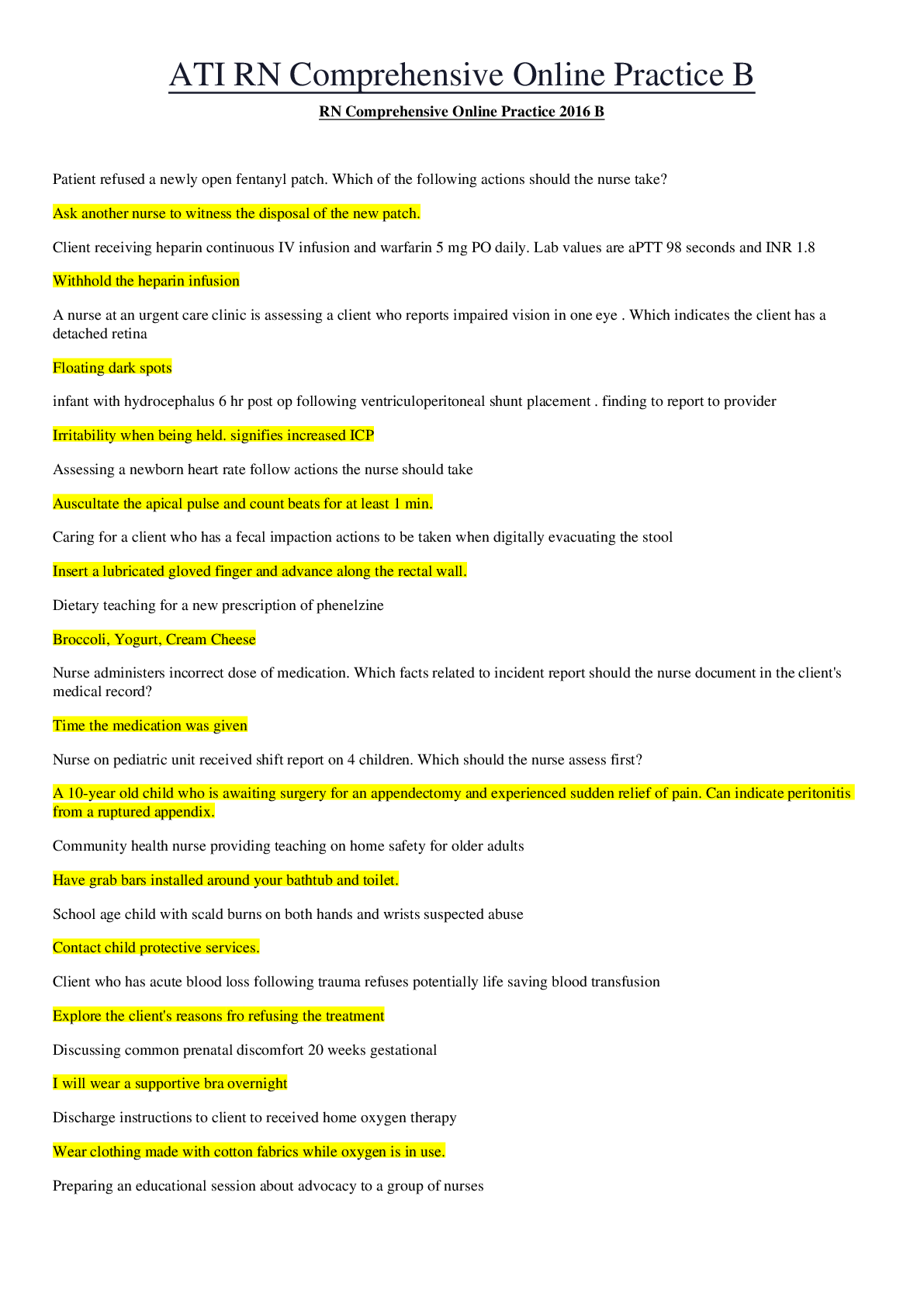
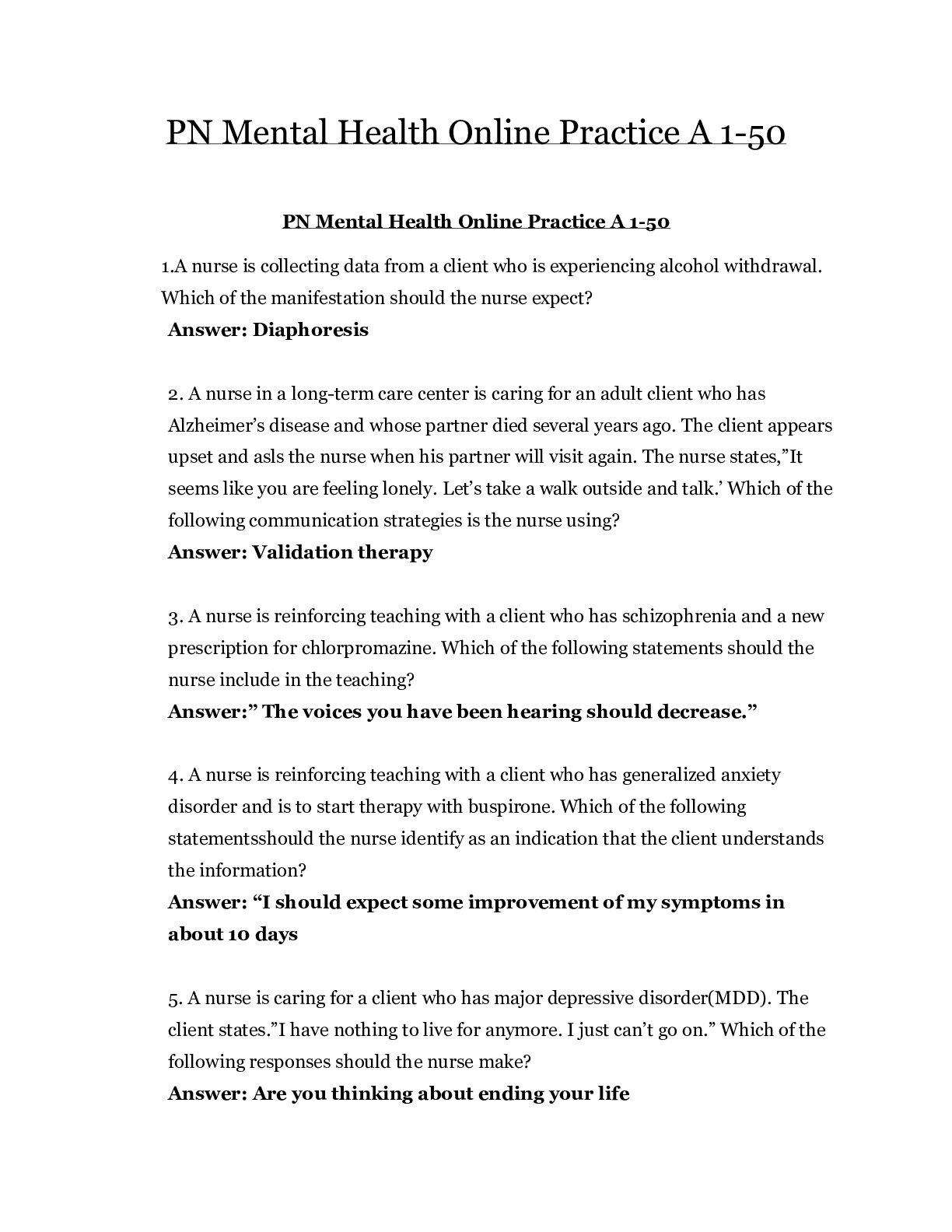
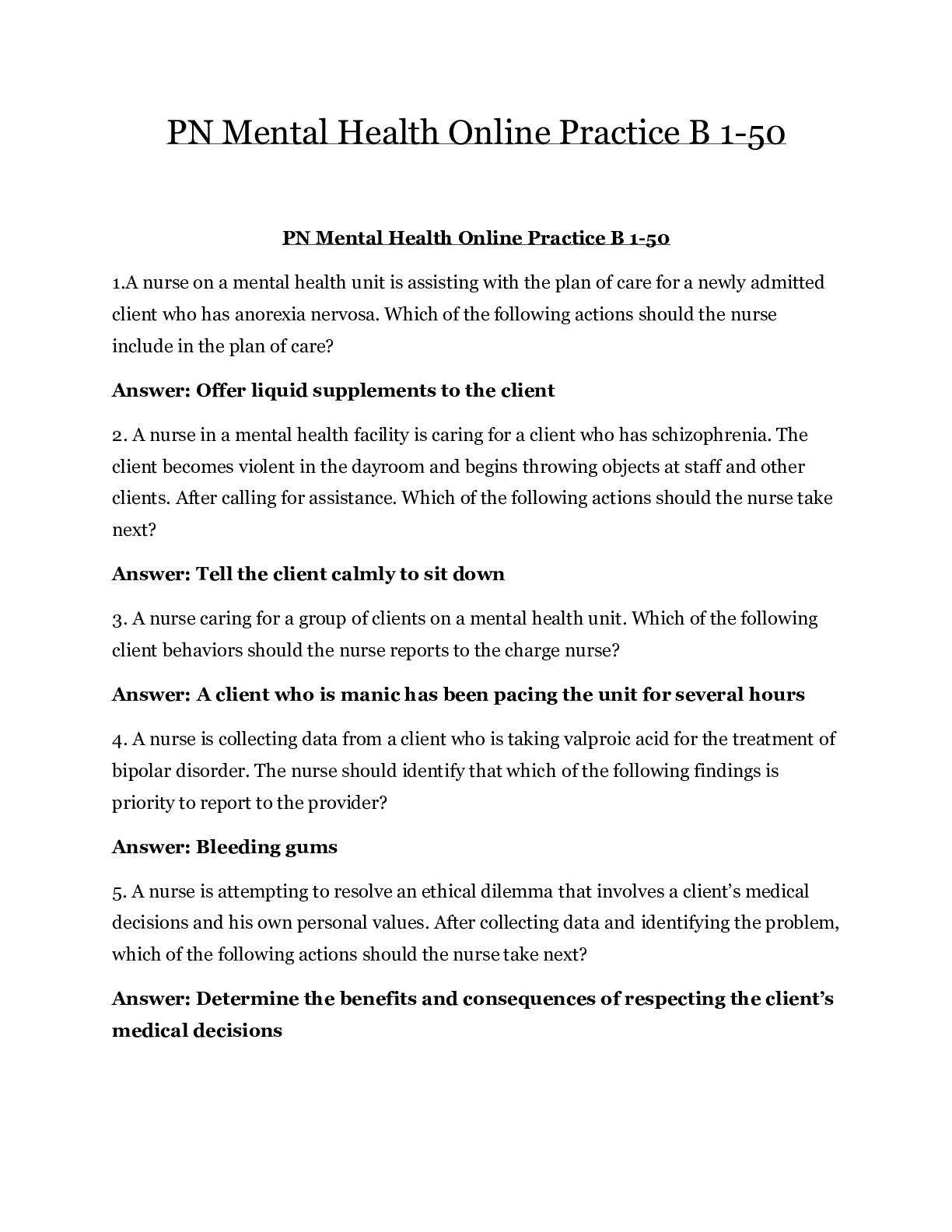
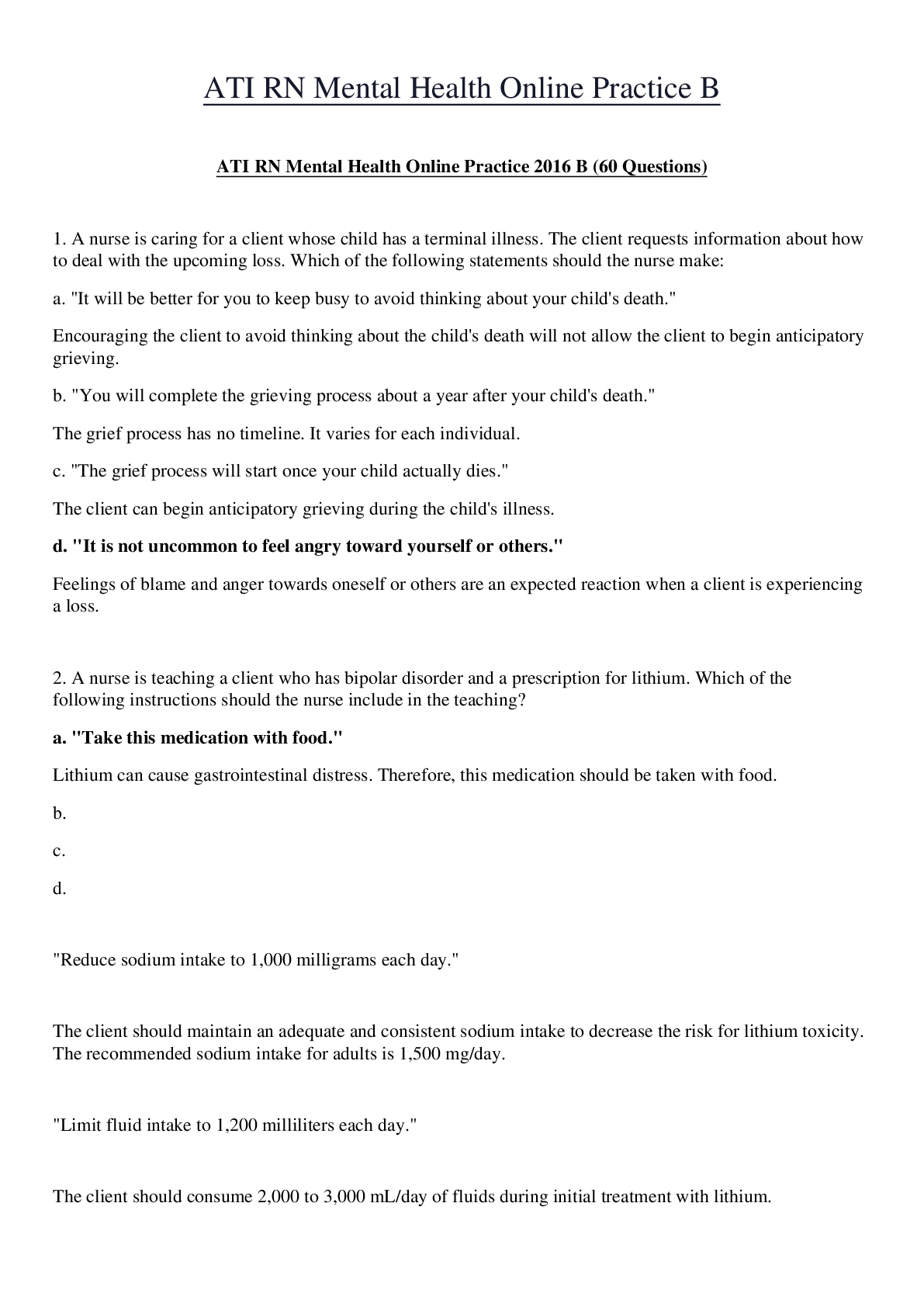


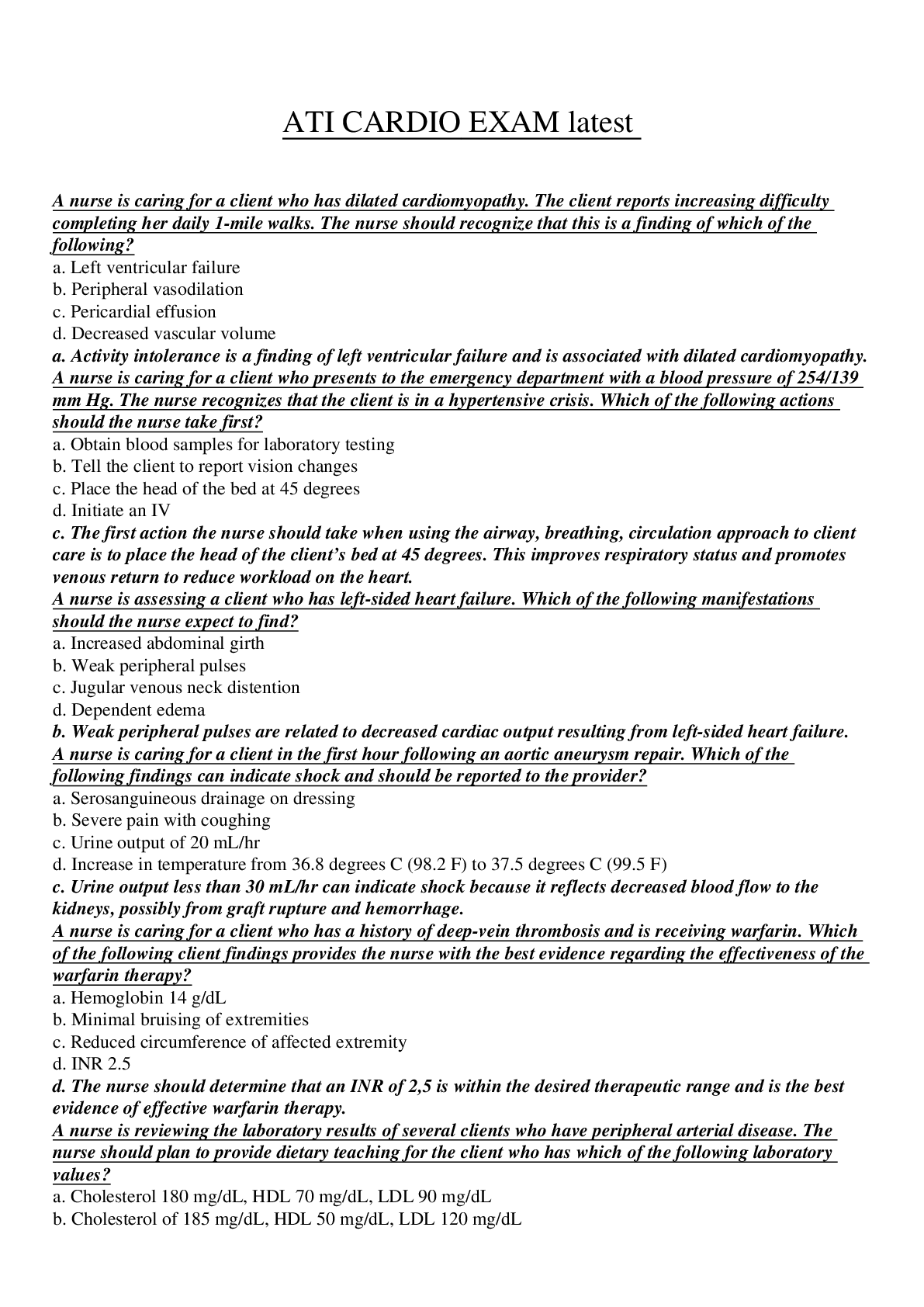
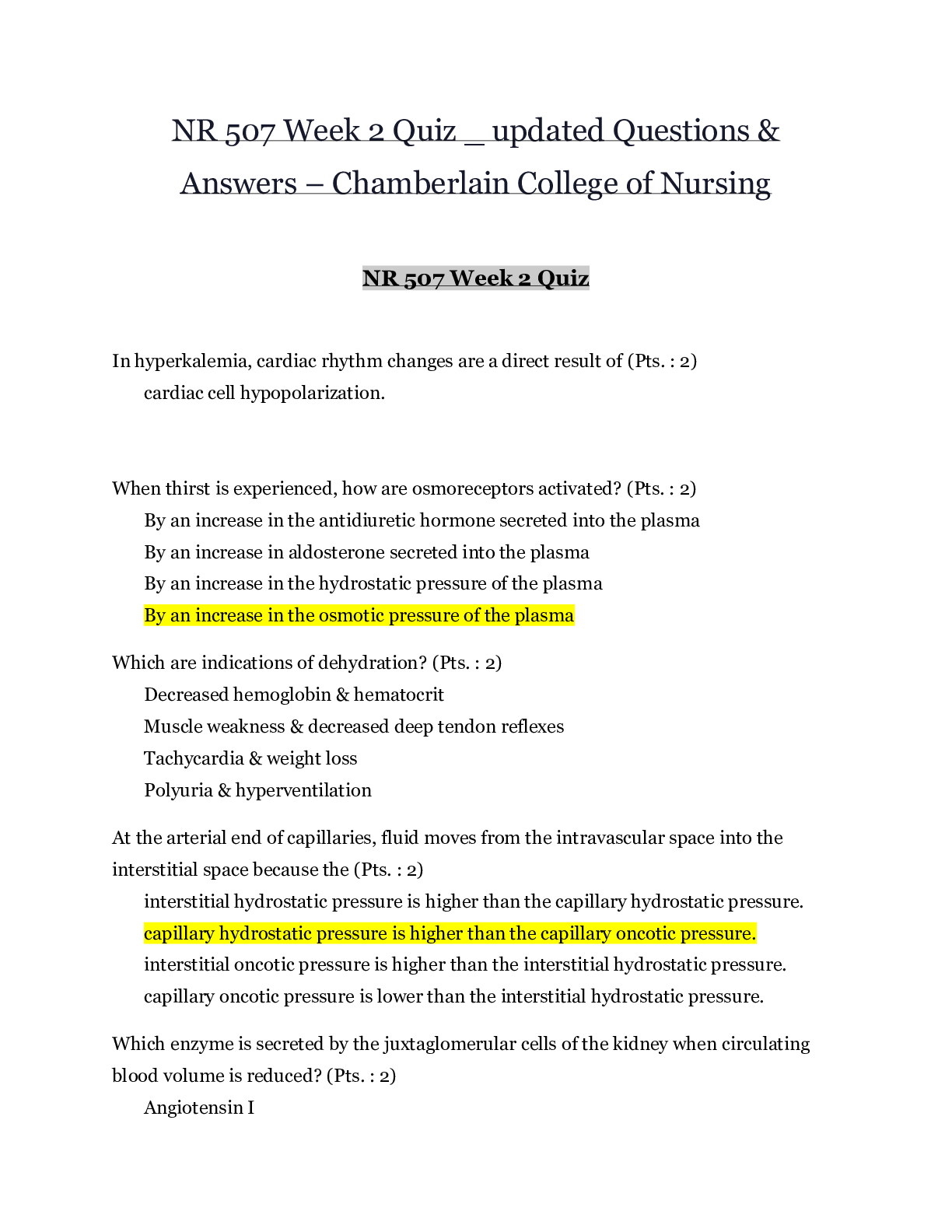
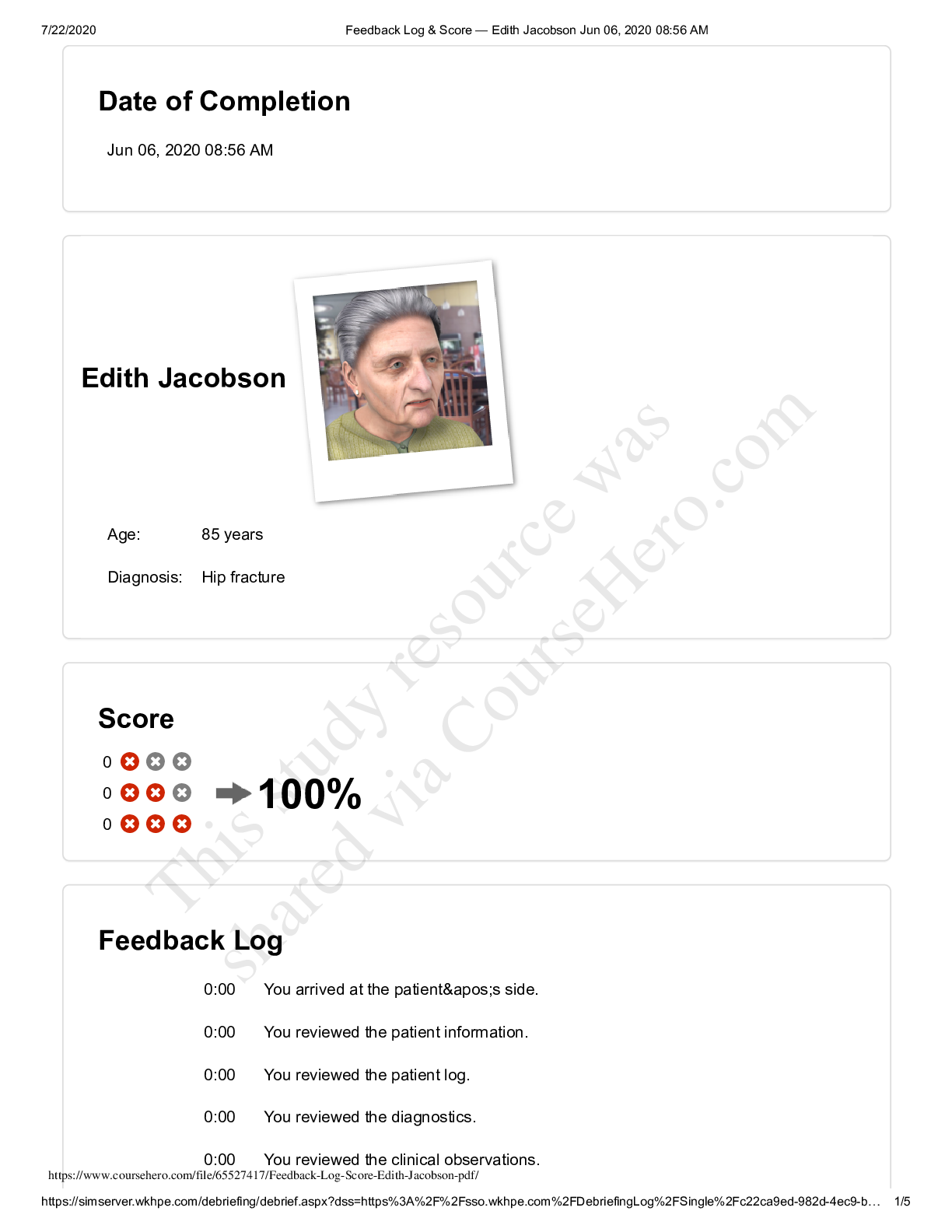
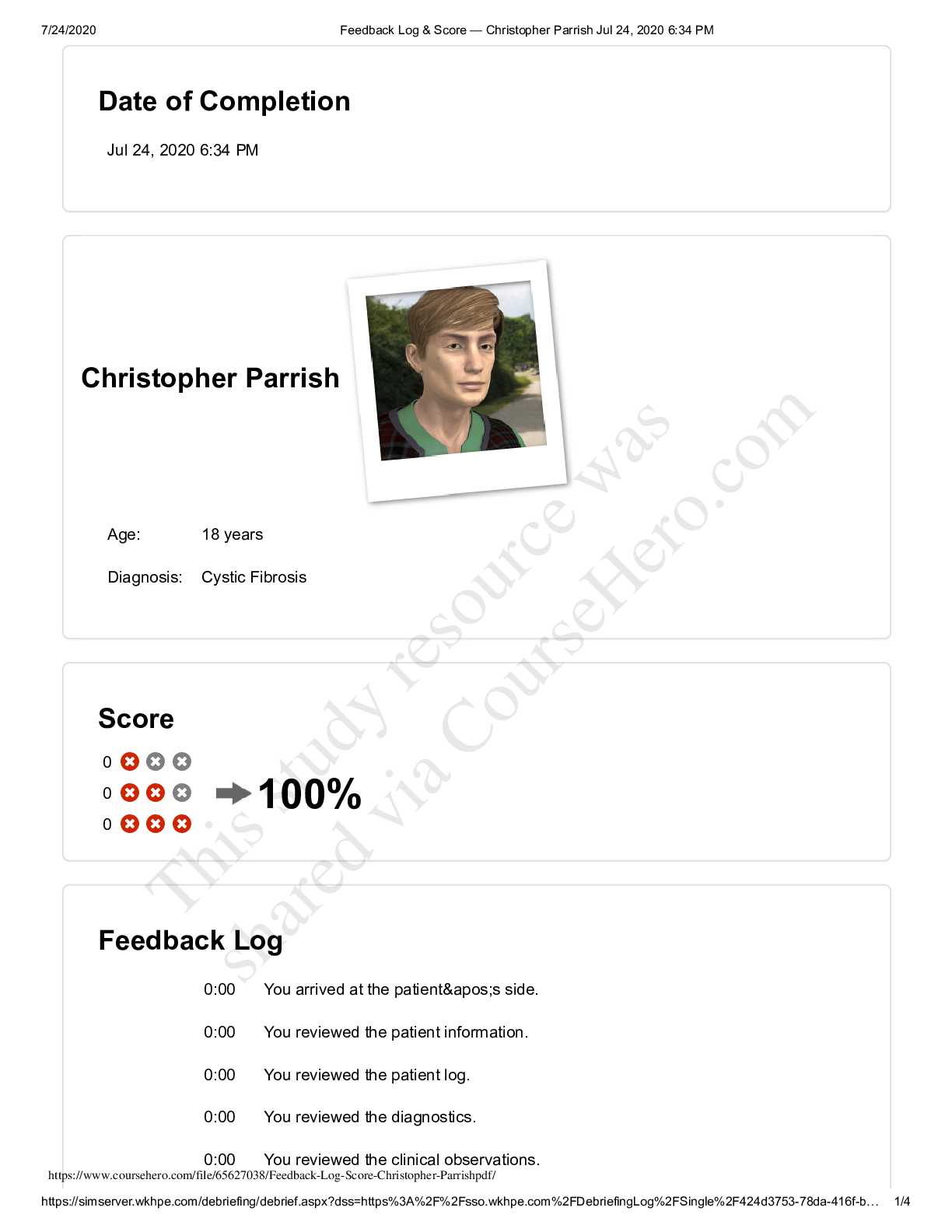
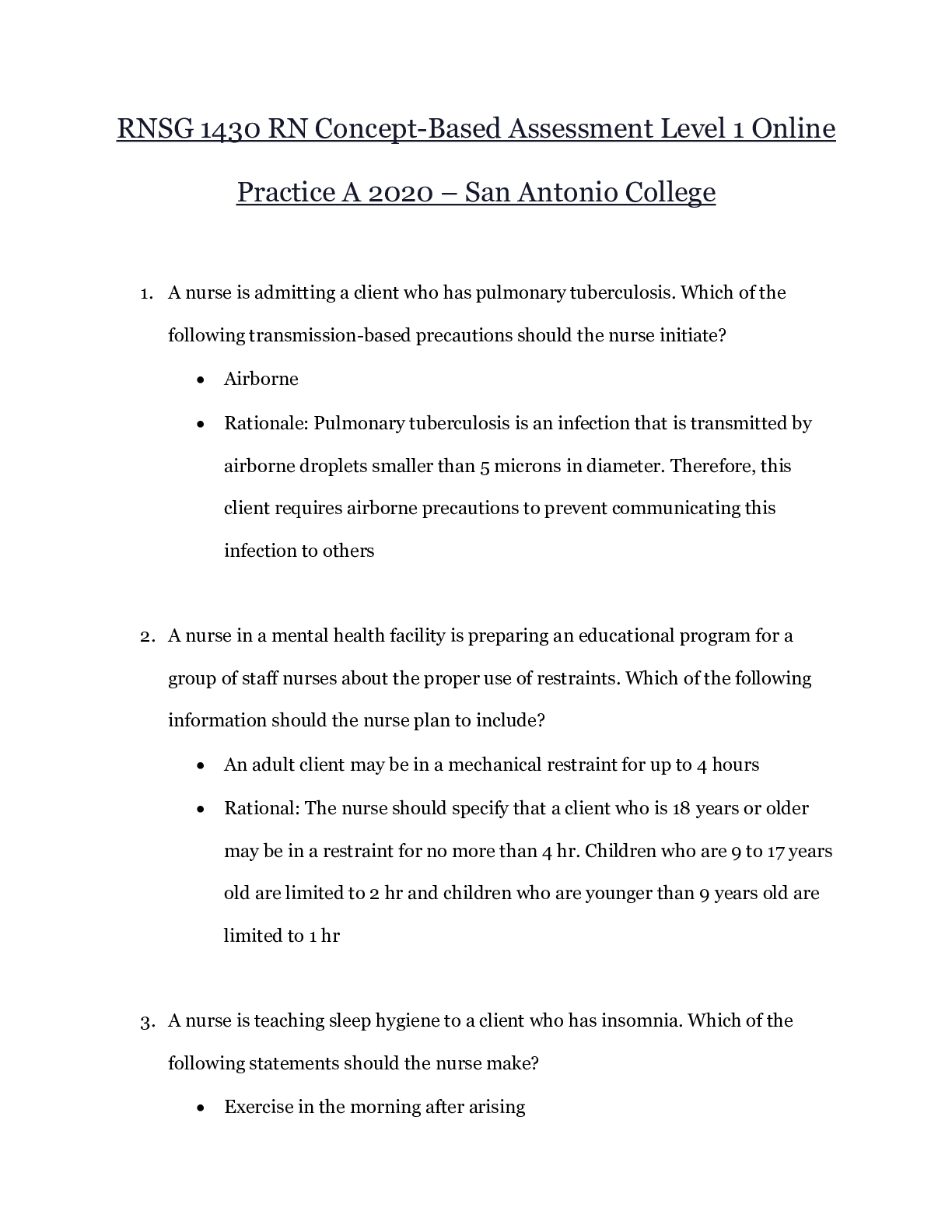


 – CHAMBERLAIN COLLEGE OF NURSING.png)
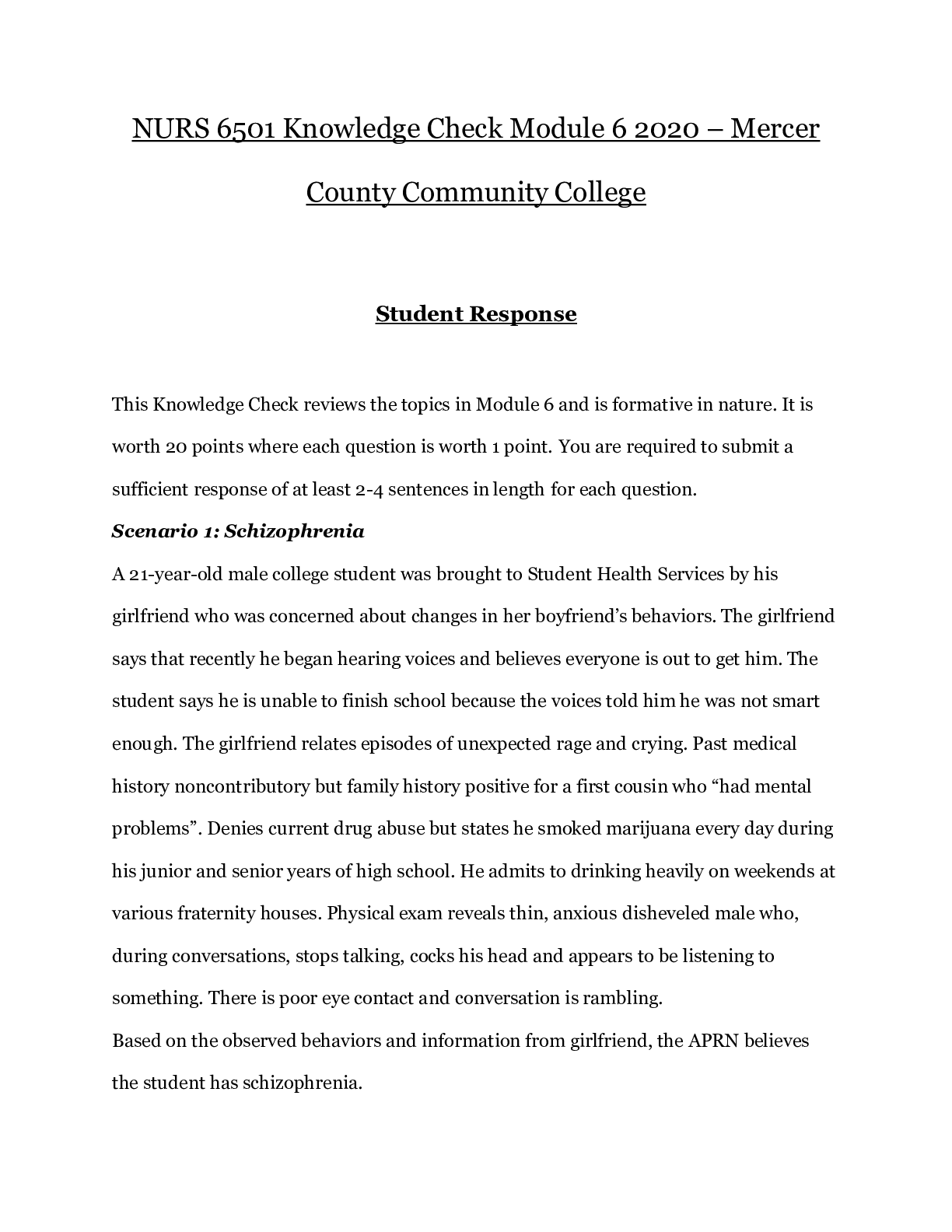
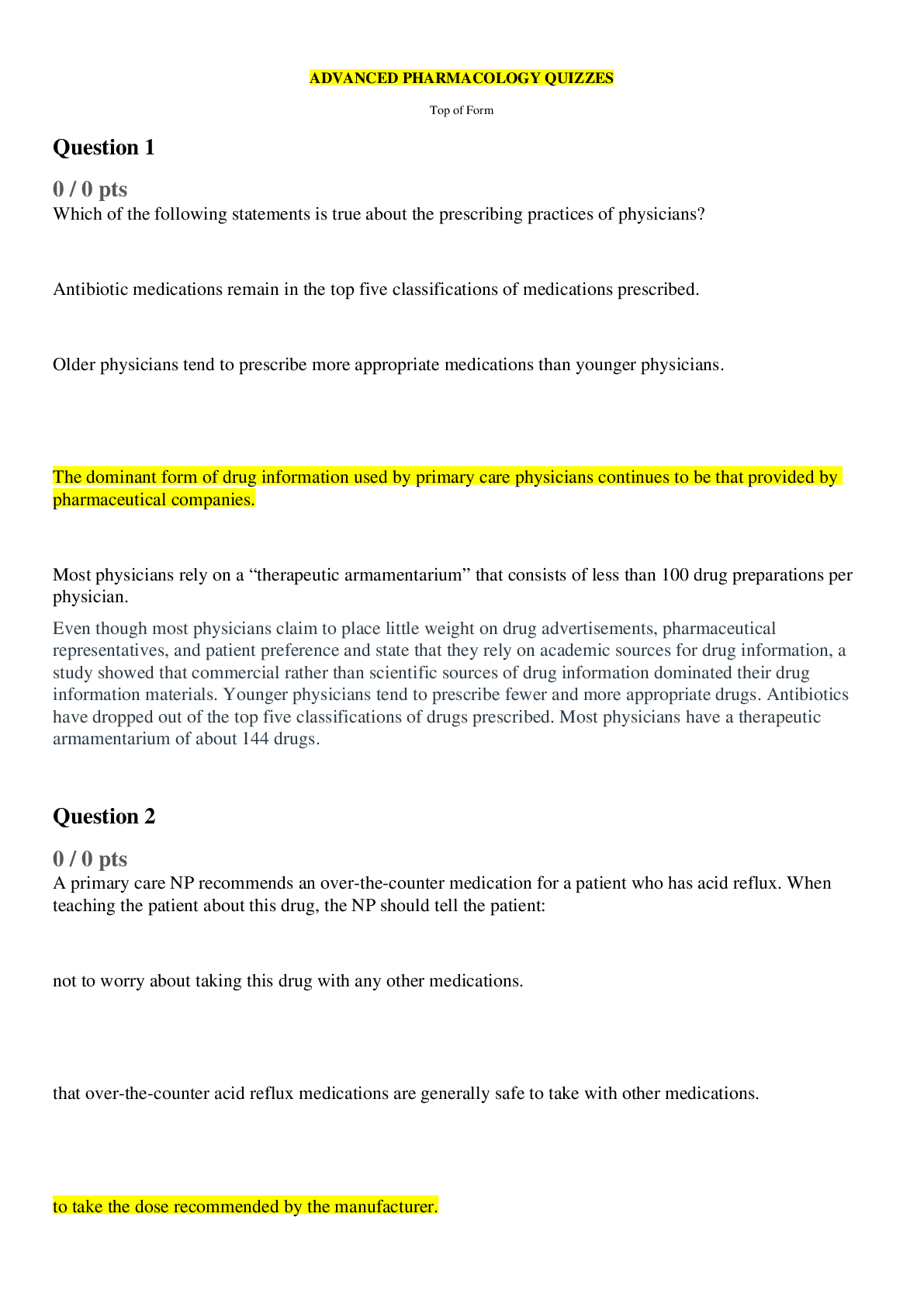

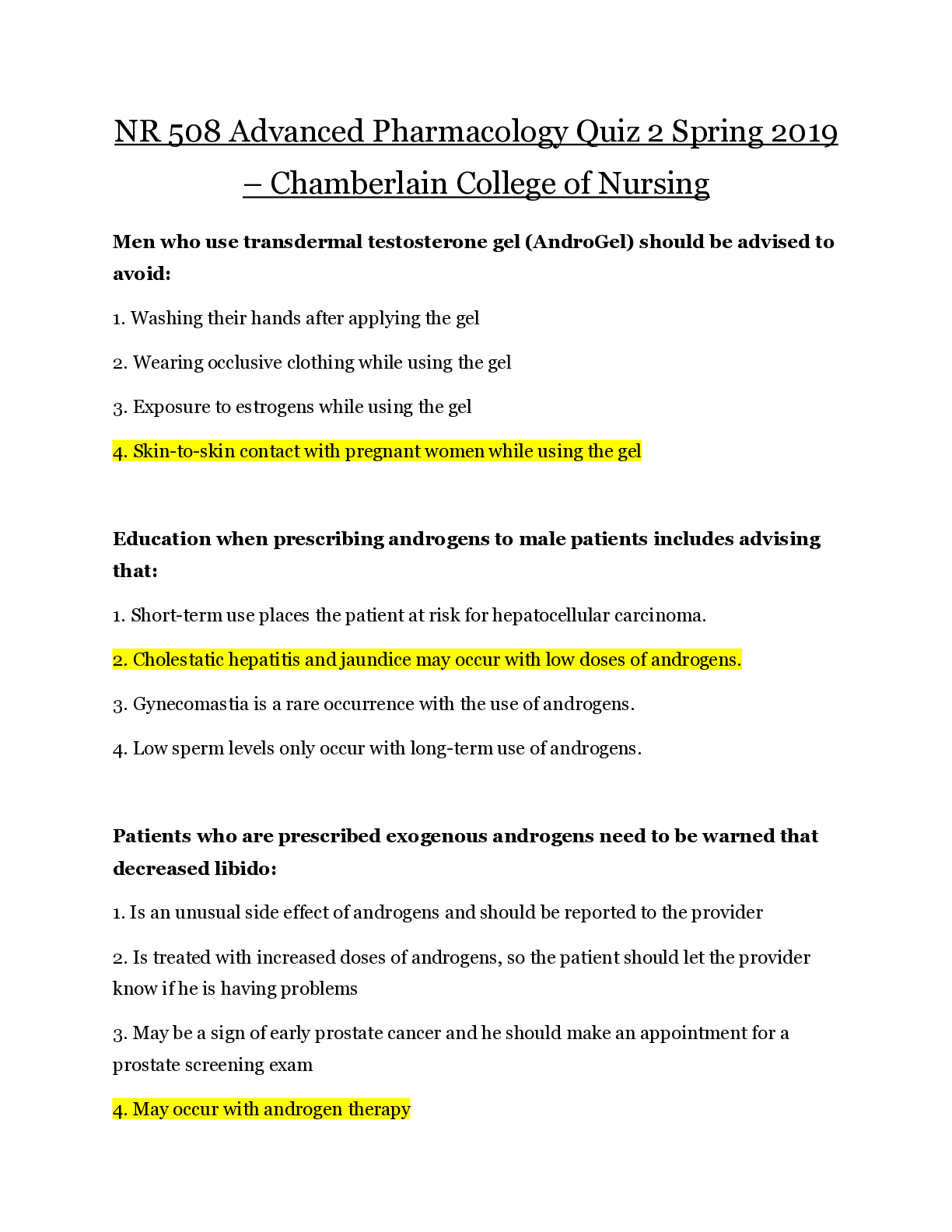
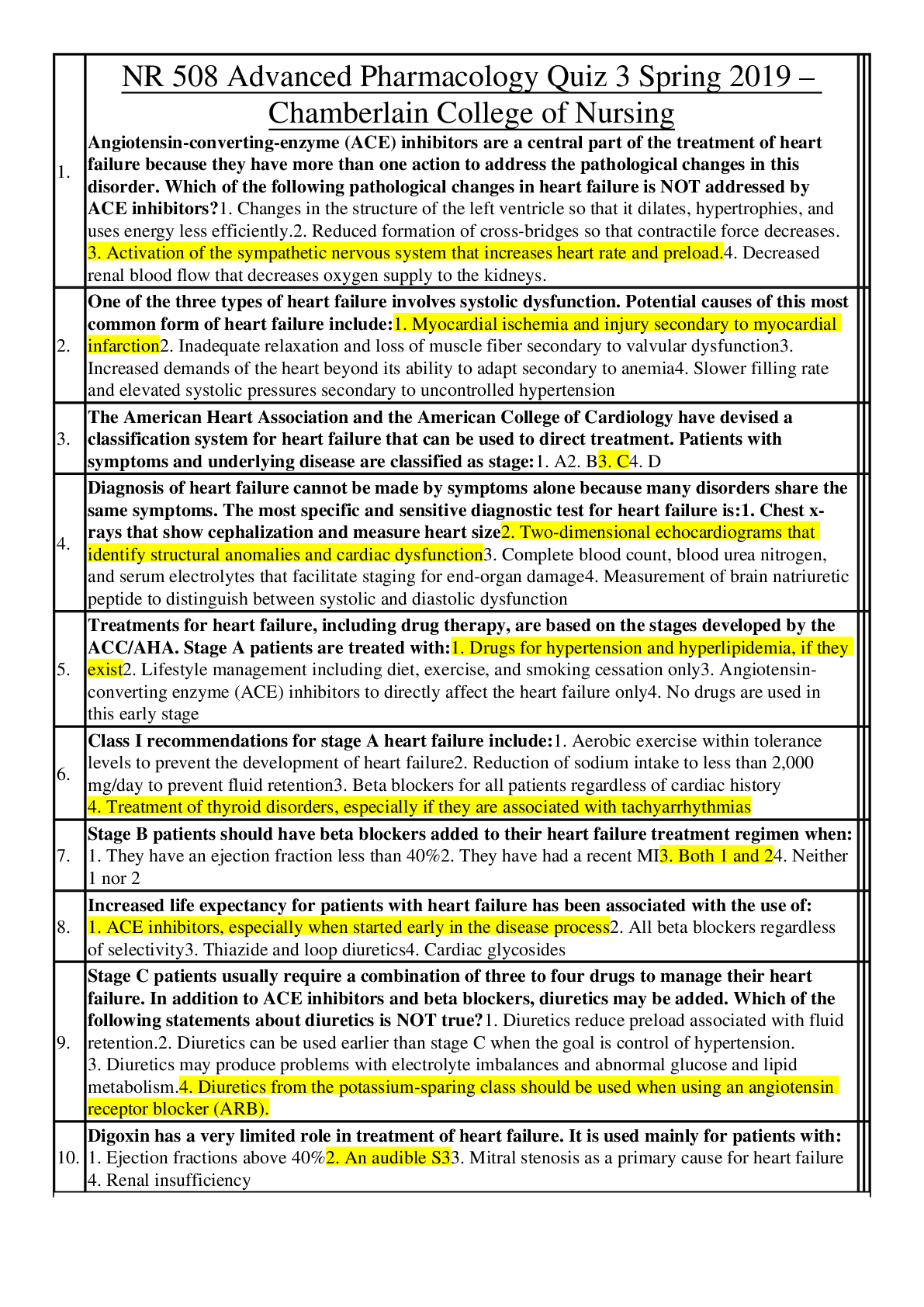

.png)


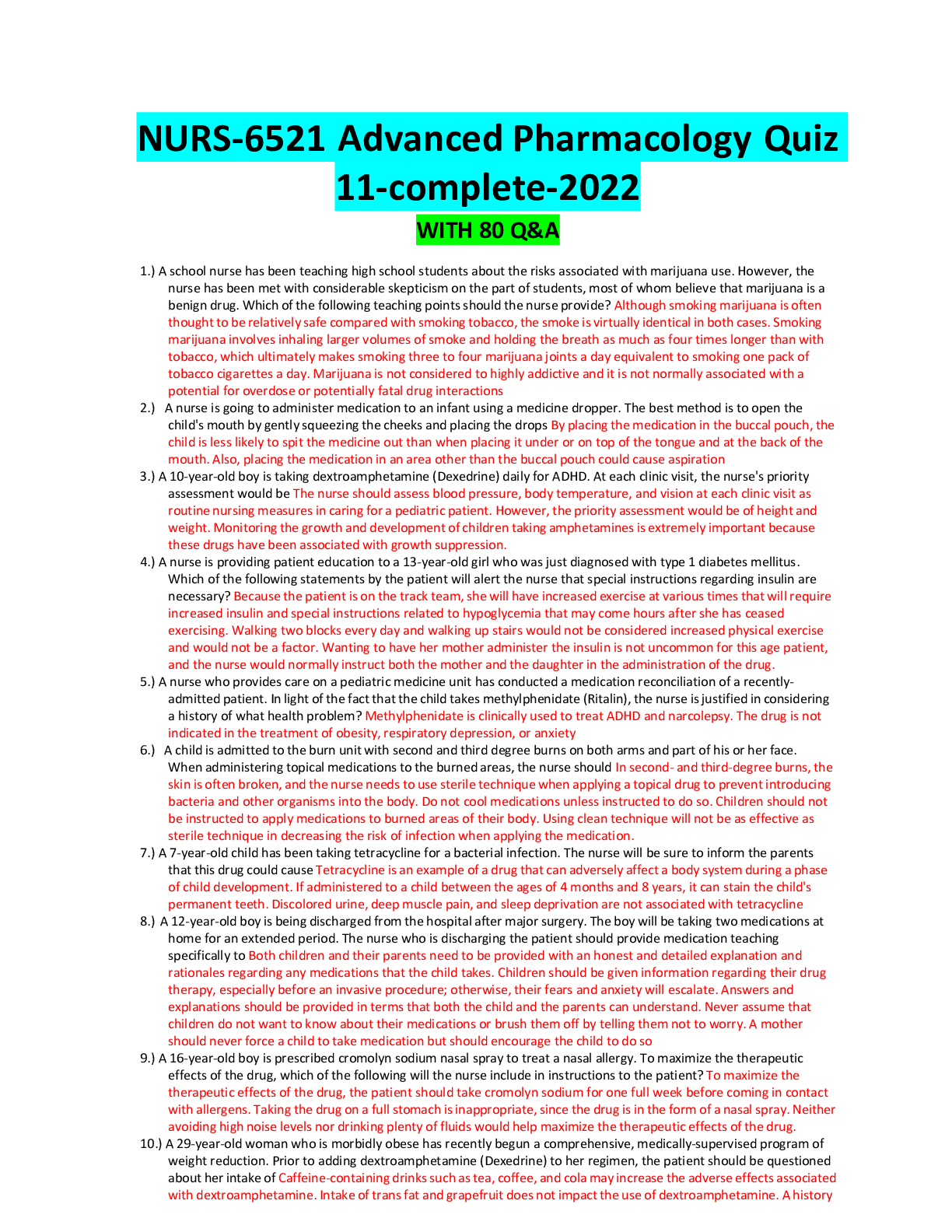
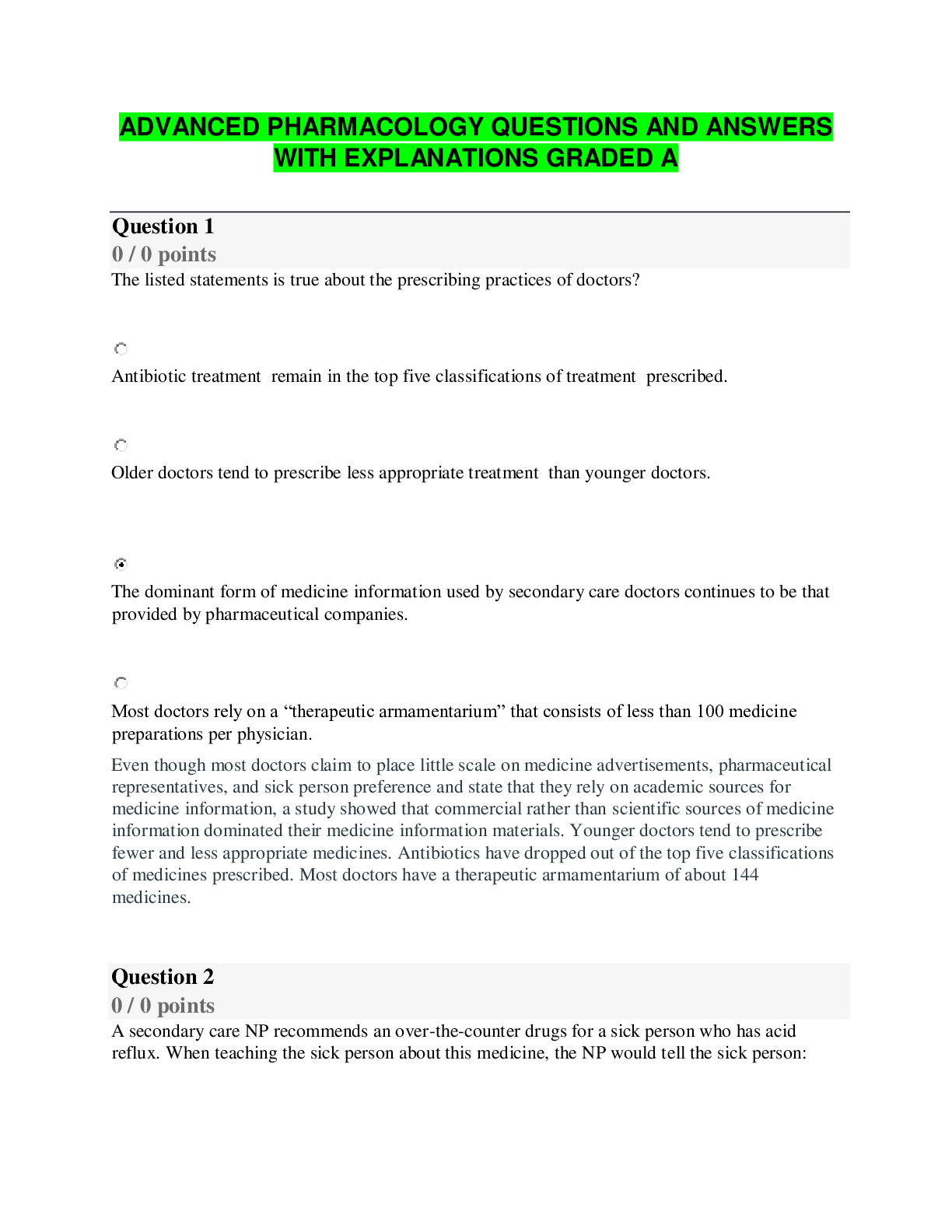
.png)
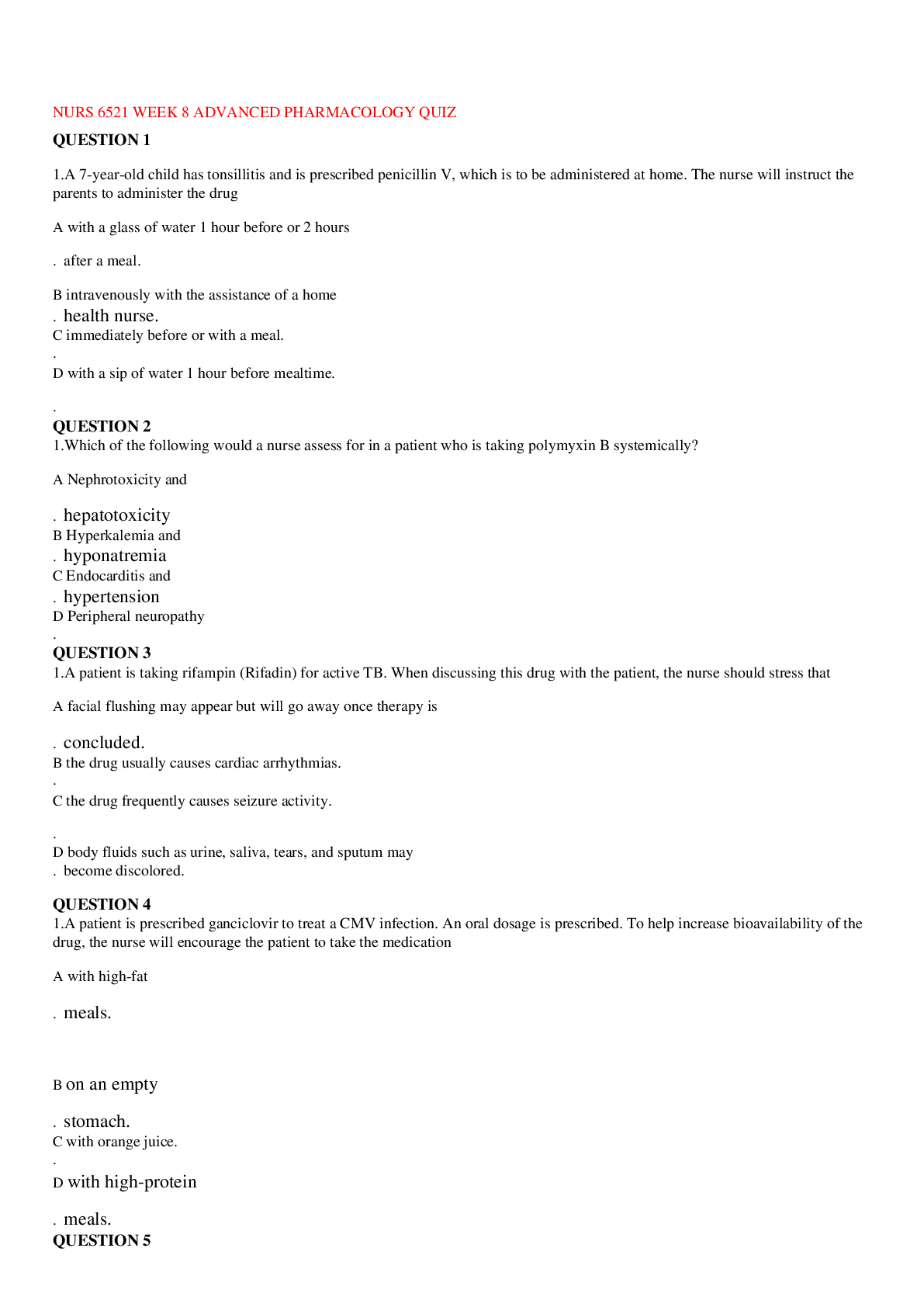
.png)
